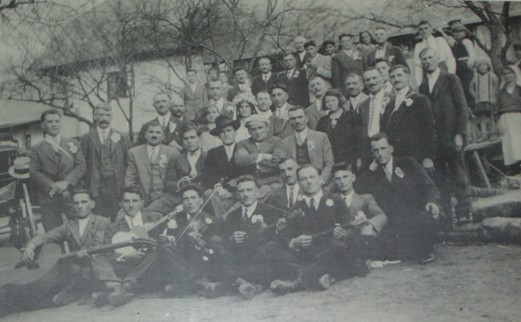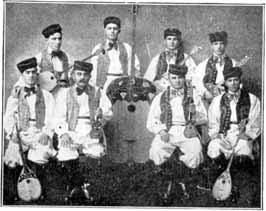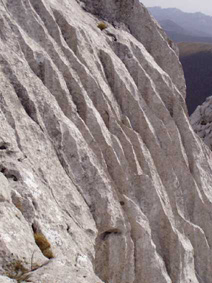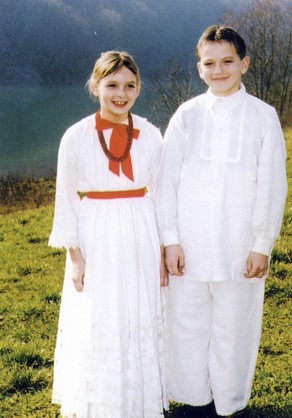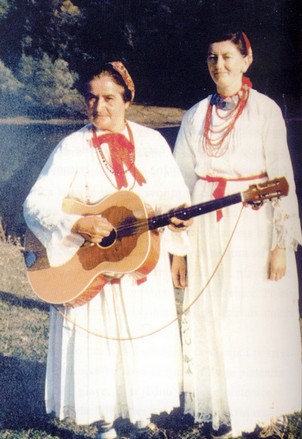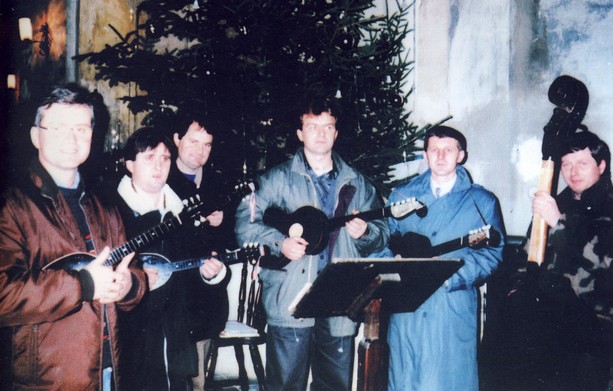 | Croatian tamburitza tradition goes back to the mid 19th century, when orchestral tamburiza play has been introduced in the city of Osijek on the NW of Croatia. It soon became quite widespread, not only in Croatia, but in many other countries throughout the world. Tamburitza play is an essential part of Croatian music culture, recognizable throughout the globe, especially in the USA, Argentina, Chile and Australia. In Croatia, there even used to be tamburitza orchestras for blind children. Orchestras for girls and women bear witness of an early emancipation of Croatian women already in the early 1900s. On the photo see Ann Elias from the Croatian Tamburitza Orchestra in the USA between the two World wars. |
| With this article, we wish Marry Christmas and a Happy New Year to all Croatian families worldwide, as well as to all the people of good will.
Several useful harmonic recepiesThe creation of this HTML has been motivated by the interest shown for our folk songs, that I noticed while browsing through the letters sent to the webmaster of the Croatian home page (mr. Josip Jurich). I provide my comments in English, since there are many Croats and their descendants throughout the world who do not speak Croatian any more, or only very little.
Let me start with a very nice (and simple) song Ne dirajte mi ravnicu (listen to it!), which for sure will live among the Croats for many generations.
A word of caution for the Croatian reader: the tone or chord B is used in the meaning of the American notation, which differs from the Croatian: in Croatia we would write H instead of B. Thus the American B = the Croatian H, and The American notation, which we use here, is accepted also in some European countries, especially in jazz literature. |
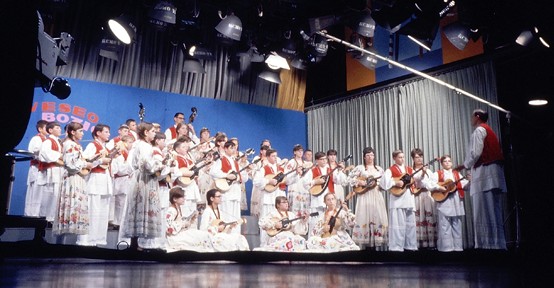 |
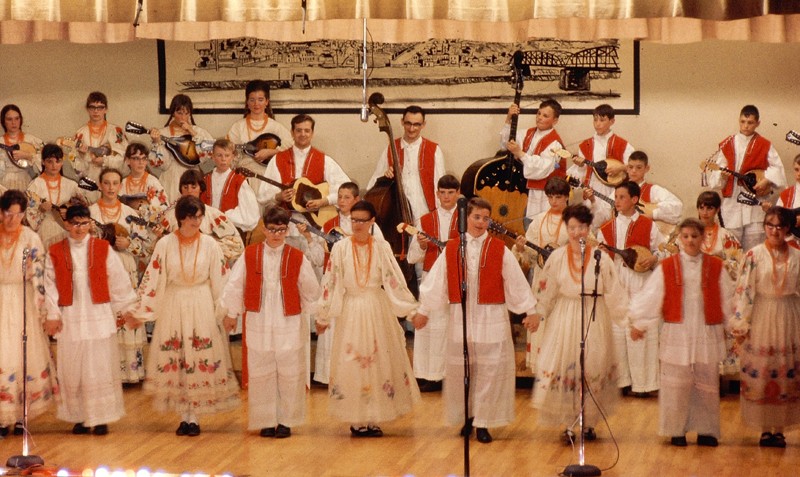 |
Croatian Christmas on Strawberry Hill, Kansas City, USA
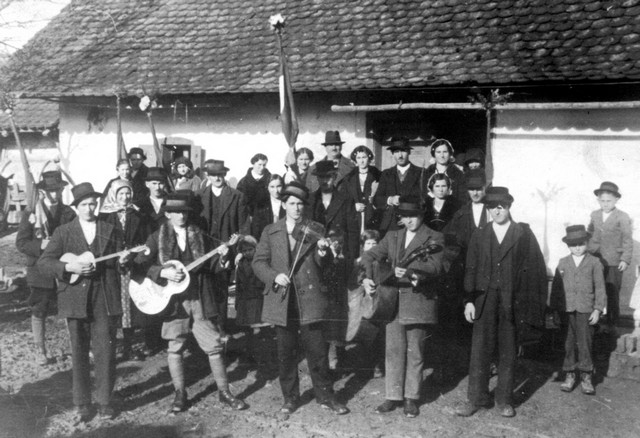
Village of Samarica in Moslavina, North of Croatia
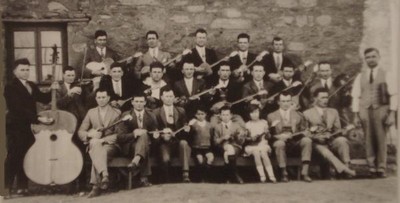
Broken Hill-based Croatian tamburica orchestra in Broken Hill, New South Wales, Australia, 1929, see [Sutalo]
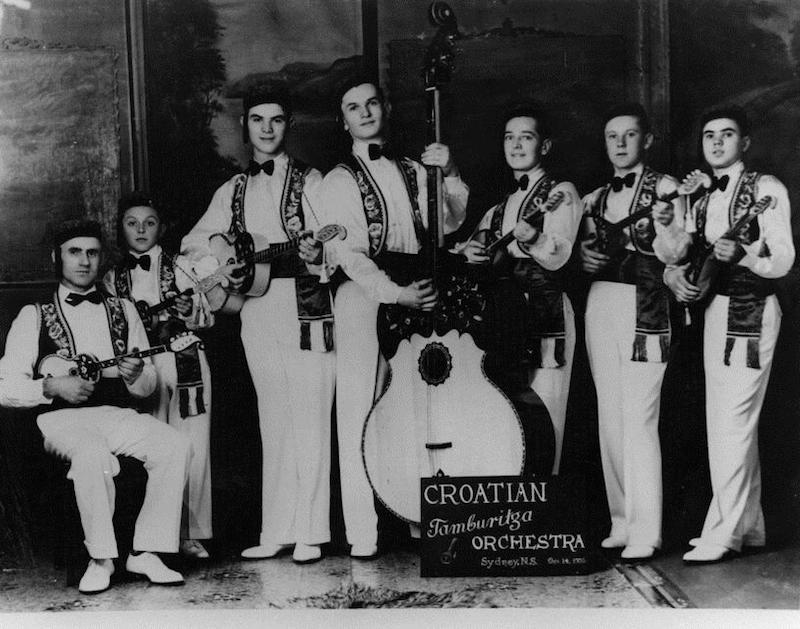
Croatian Tamburitza Orchestra in Sydney, 1930. Photo from Beaton Institute.
 Let me add one of my favourite songs, a true jewel in both music and verses, very popular among the Croats and others in Baccka and Srijem. The harmonization below differs considerably from the usual one that we can hear on recorded materials, including also the interpretation of the famous orchestra of Janika Balazz, the uncrowned king of tamburitza (sedam tamburassa Janike Balazza). This Bogdan's song is written in ikavina dialect (for example "divojka, pisma"), typical Croatian dialect, now disappearing among the Croats in Backa (Bunjevci and Sokci), due to intensive serbization. Ikavian dialect is still very widespread also in Croatia and Bosnia and Herzegovina, and has a tremendous literature since the time of Marko Marulic (15th century).
Let me add one of my favourite songs, a true jewel in both music and verses, very popular among the Croats and others in Baccka and Srijem. The harmonization below differs considerably from the usual one that we can hear on recorded materials, including also the interpretation of the famous orchestra of Janika Balazz, the uncrowned king of tamburitza (sedam tamburassa Janike Balazza). This Bogdan's song is written in ikavina dialect (for example "divojka, pisma"), typical Croatian dialect, now disappearing among the Croats in Backa (Bunjevci and Sokci), due to intensive serbization. Ikavian dialect is still very widespread also in Croatia and Bosnia and Herzegovina, and has a tremendous literature since the time of Marko Marulic (15th century).
Već odavno spremam svog mrkova
Zvonko Bogdan
Dm Gm Dm G0 D0A7Dm CSee also another Bogdan's beautiful song written in the Croatian ikavian dialect: Hej, salaši.
1. Već odavno spremam svog mrkova,
F Bb F C C7 F A7
da se prođem ka-som od miline.
Bb E7 F D7 Gm C7 F A7
Da obiđem staze, staze svog djetinjstva, |
Dm Gm Dm C C7F A7 | 2x
Dm Gm Dm G0 D0 A7Dm |
za salašom želja da me mine. |
Refrain:
F C F
Neću više ići na tu stranu,
jer ne mogu suze oku skriti.
Nema više starog čardaka ni đerma, | 2x (the same
ni debela 'lada od bagrema. | harm. as above)
Ili moram tugom okrenuti glavu, | 2x (the same
il plakati ili se napiti. | harm. as above)
2. Nema više dobrih tamburaša,
fijakera, snaša, i salaša.
nema više konja, konja koji jure, | 2x
a u stvari nikuda ne žure. |
(without refrain)
3. Vrag nek nosi moje snove puste,
divojačke duge kose guste.
Vrag nek nosi tugom dobre tamburaše,
fijakere, pisme i salaše.
Refrain:
Neću više ići na tu stranu,
jer ne mogu suze oku skriti.
Ili moram tugom okrenuti glavu,
il plakati ili se napiti.
Comments:
- D0 = Ddim. Its usage often yields a very nice `sporadic' bass melody. You can also play A7 instead of D0.
- E7 is surprising, and sounds very nice. It connects the chords Bb and F. More precisely, the idea is to fill in the passage from Bb to F by using the chord diminished by ONE degree with respect to F: this is E7. In other words, we enter F from below. It is worth noting that it is precisely the seventh in the E7 chord, which gives the same tone as the one in the melody in the moment of usage!
- To see the meaning of this chord (E7), try to play the song without E7, i.e. with Bb instead.
- There is a lots of back-cycling here:
- C -> F,
- D7 -> Gm -> C7 -> F (look at the cycle of fourths above).
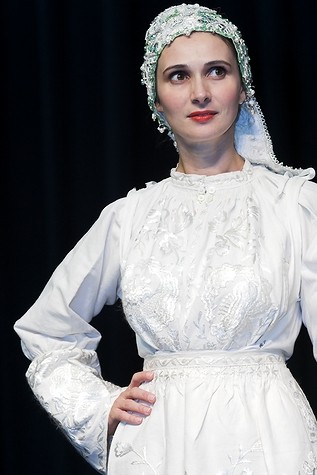
CroatiaFest 2005, Seattle, USA, Photo - Jal Schrof
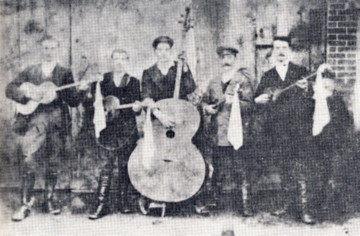
Croatian tamburitza orchestra from Virje, nicely decorated with white scarfs;
beginning of 20th century [Ivancan, p. 121]
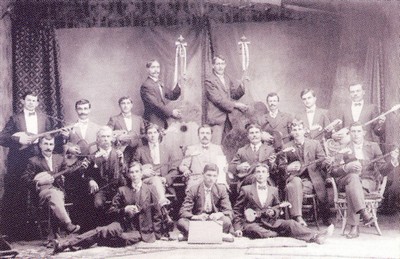
Croatian tamburitza orchestra in Australia, 1910
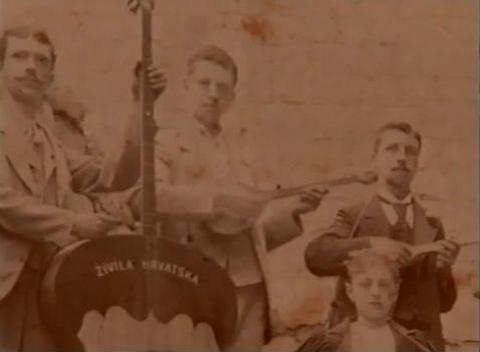
Tamburitza orchestra in Janjina on Pelješac peninsula,
with inscription "Živila Hrvatska" - "Long Live Croatia" on the bass.
Janjina is the birthplace of Miho Bjelovučić, father of the famous Ivan Bjelovučić who was the first in history to fly over the Alps in 1913,
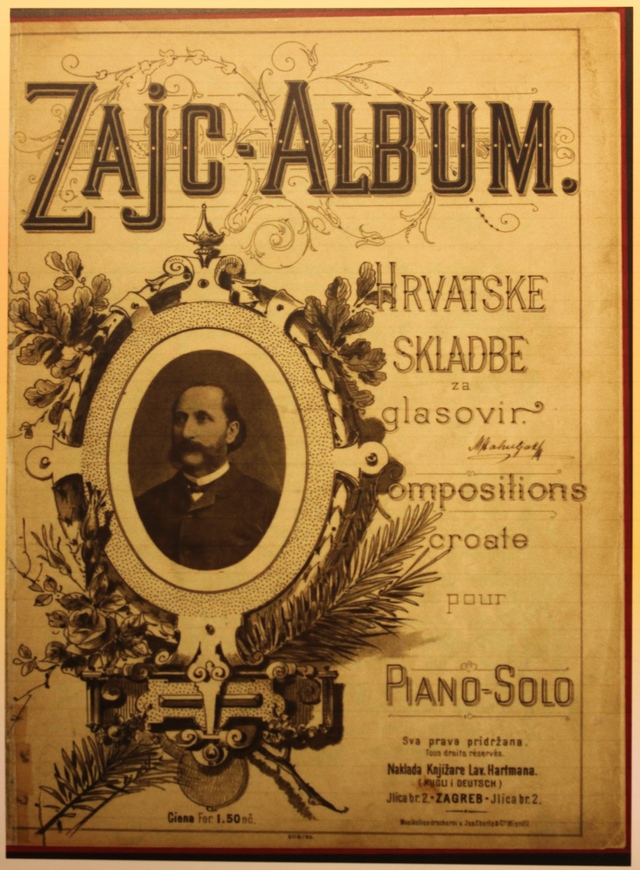
Ivan pl. Zajc: Hrvaske skladbe za glasovir, Zagreb 1890.
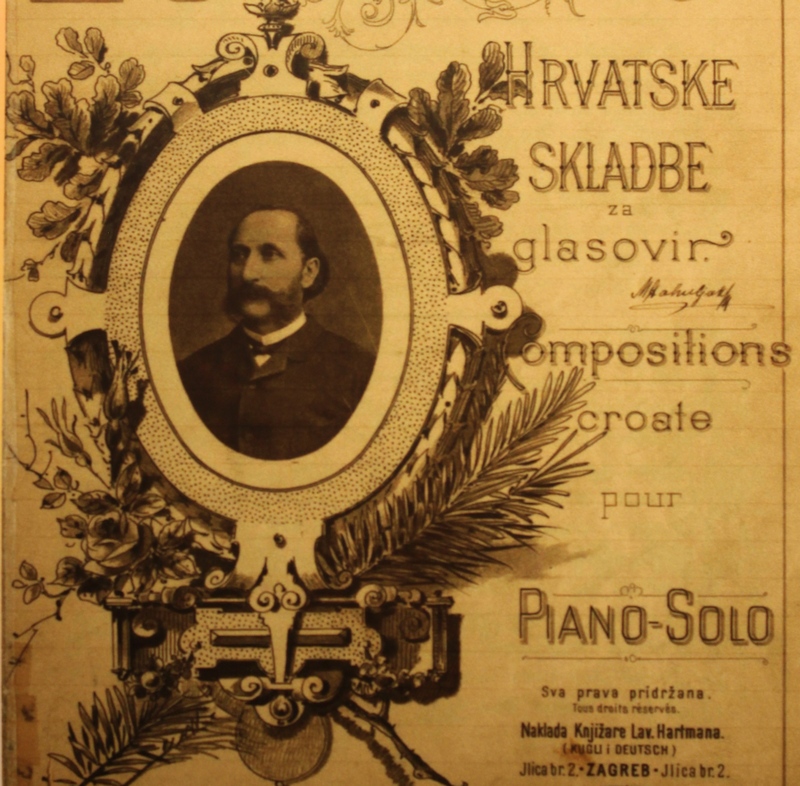
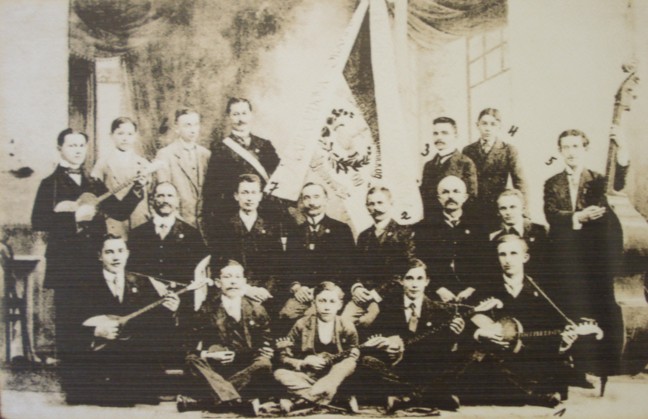
Tamburica orchestra from Bjelovar, around 1900.
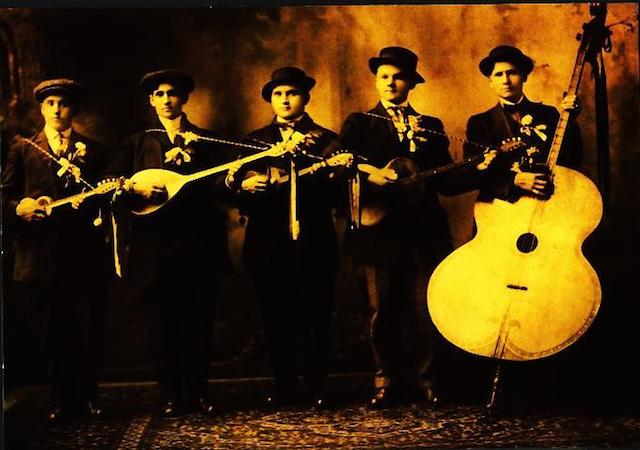
Old Tambura Band, Youngstown, Ohio, USA
Another jewel. Kajkavian verses by Dragutin Domjanić, music by Vlaho Paljetak (born in Dubrovnik!).
Popevke sem slagal
G
1. Popevke sem slagal,
Em D7 G E7
i rožice bral,
Am D7
i (v)su svoju radost
Am D7 G
sem drugim ja dal.
2. Al' žalost navek sem,
vu srcu ja skril,
ni nigdo me žalil,
i sam sem tak bil.
G G7
3. Al' v mojem srcu,
E7 Am
tam suzah vam ni,
Cm G Em
i če mi je teško
A7 D7 G
popevka zvoni.
Če siromak sem
se drugim bi dal
popevke i srce
i ne bu mi žal.
Vlaho Paljetak (1893-1944), born in Dubrovnik, left us beautiful verses and music in kajkavian language of the Croatian north-west.
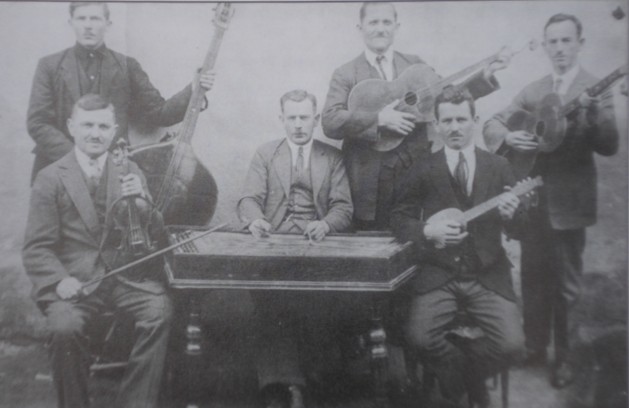
Vocinski tamburaski orkestar (Vocin tamburitza orchestra), 1928,
photo kept in Zavicajni muzej Slatina
Dragutin Domjanić (1875-1933), a very popular kajkavian poet, wrote that according to their family tradition they stem from Bosnia. He was a stipendist of the cultural society Napredak from Bosnia and Herzegovina. See his verses1, verses2, verses3.
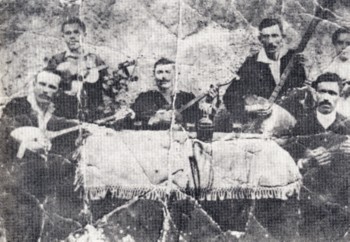
Tamburitza players from Virje from the turn of 19/ 20th centuries [Ivancan, p. 205]
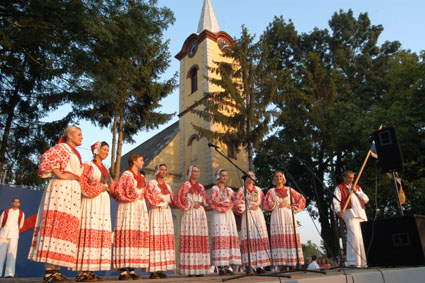
Many thanks to Ipik for very nice photos of Croatian national costumes.
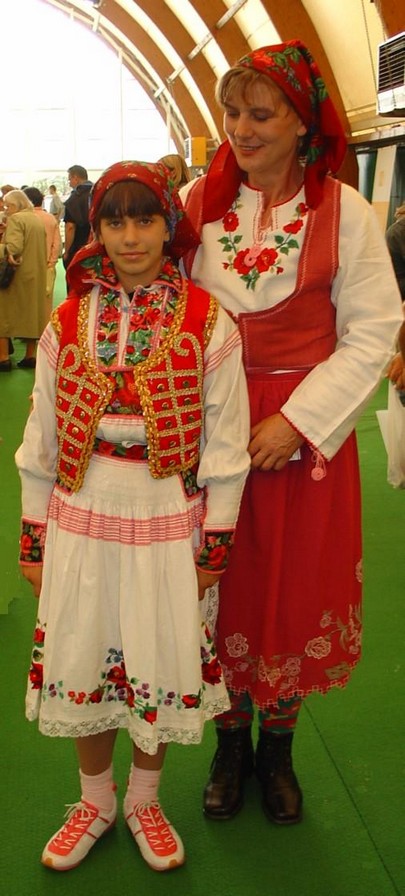 | 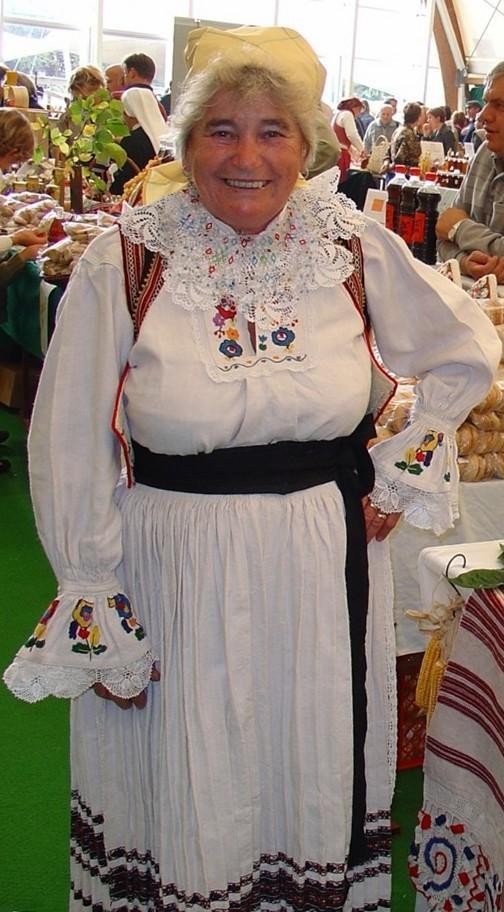 |
Women in Croatian national costumes from the environs of Zagreb, Bocarski dom, Zagreb, 2006 (festival of Croatian gastronomy)
Croatian Tamburica Band at the wedding, ca 1930, USA
Croatian Tamburica Band at the wedding, ca 1930, USA. Source.
Fala
Verses: Dragutin Domjanić, music: Vlaho Paljetak
G C G
1. Za saku dobru reč,
C G0 G
kaj reči si mi znala!
Am D7
Za saki pogled tvoj,
A7 D7 D
za saki smeh tvoj fala!
2. Tak malo dobrega,
v živlenju tuj se najde.
I če je sunca trag,
za oblak tak i zajde.
G F E7 Am
3. Jer ti si srcu mi,
Am D7 G
tak puno sunca dala!
G F E7 Am
Kaj morem ti neg reč,
Am D7 G
od seg ti srca fala.
(repeat 3.)
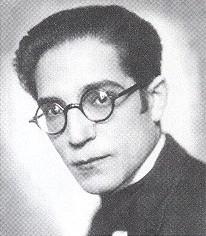 | 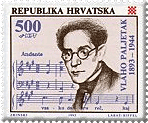 |
Vlaho Paljetak (1893-1944), born in Dubrovnik, on the photo and on the stamp.
The song has been rearranged by a well known conductor Emil Cosetto, on the occasion of Tito's death in 1980. It is regrettable that the message of this beautiful, innocent song has been so distorted.
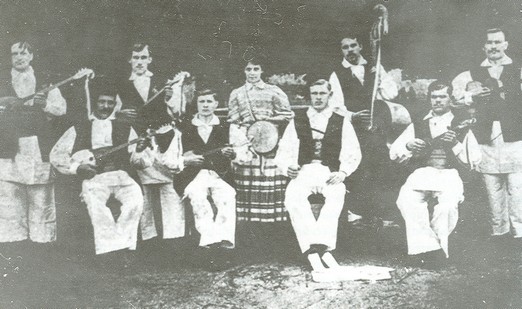
Hrvatsko pjevačko društvo "Lovor" founded in Slunj in 1876.
(Toma Žganec: Rastoke, Na slapovima Slunjčice, Zagreb 1990., str. 106)
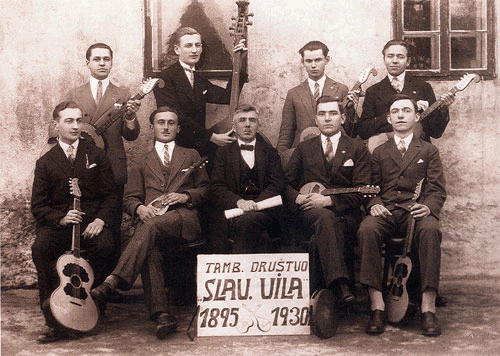
Tamburaško društvo Slavonska vila iz Orahovice, 1930, source.
Stoje: Ivica Grbić, Franjo Hocenski, Josip Filaković, Franjo Kikel.
Sjede: Ladislav Hocenski, Vencl Konopek, učitelj društva Viktor Albih (stolar),
Vlatko Voćinkić i Stjepan Bradač.
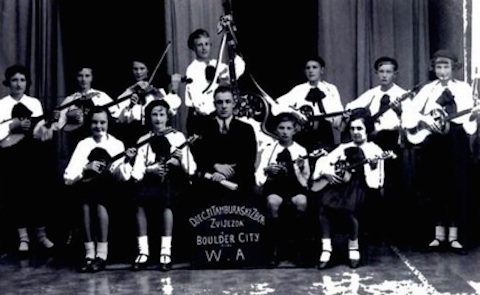
Dječji tamburaški zbor Zvijezda (Children Tamburitza Orchestra Star), Boulder City, West Australia, 1936.
Source [Šutalo, p. 209].
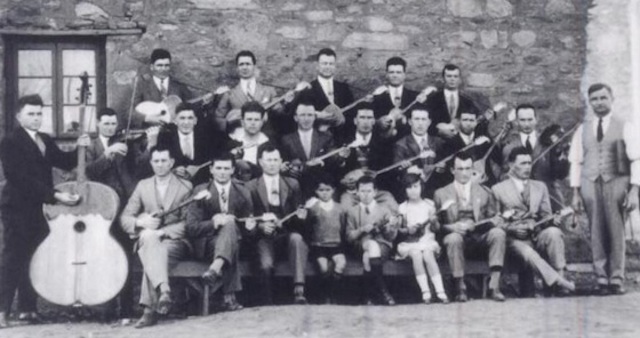
Croatian Tamburitza Orchestra Broken Hill, New South Wales, Australia, 1929. Source [Šutalo, p. 204].
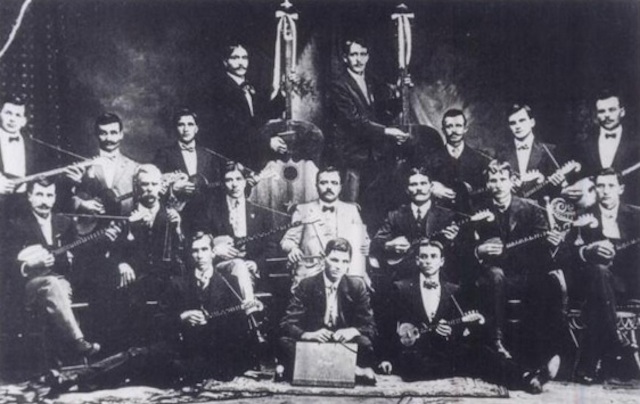
Marijana
Verses and music: Vlaho Paljetak
It is interesting and little known that in Japan there exist two recordings of Vlaho Paljetak's well known song Marijana - in the Japanese language, and the song was very popular in that country!
We invite you to listen to Vlaho Paljetak's tune O, MARIJANA, sung by Seiji Tanaka in Japanese and Croatian, recorded in 1976:
| O MARIJANA [mp3] 3.6 MB |
By the courtesy of Dr. Drago Stambuk, Croatian ambassador in Tokyo.
I had opportunity to listen them on two records issued in Japan, when I visited Mr. Mario Kinel in his apartment in Zagreb (Mr. Kinel was a well known pop-music composer and translator; he even translated Vu plavem trnaci into Italian and German). Of course, out of Japanese verses I understood only - Marijana.
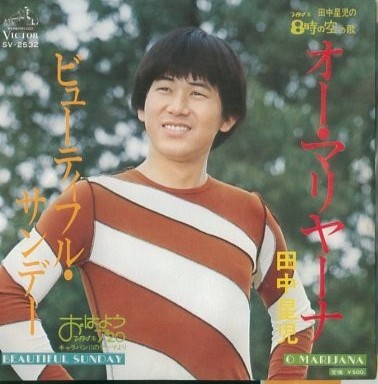
O Marijana (see bottom on the right), issued in Japan in1976, sung by Seiji Tanaka, Japanese pop singer born in 1947.
Marijana is also very popular in Czechia. It was included in both Croatian original and Czech translation into the book "Sveove Evergreeny" (World's Evergreens), published in Prague in 2000 (Petr Jansky - MUSIC CHEB). Except in Czech and Japanese, Marijana has been translated and sung in Italian, German, Russian, and Romanian.
In addition to this, I learned that a famous american actor Harry Dean Stanton ("Texas Paris Texas") sang the whole Marijana in superb Croatian to Mr Nenad Bach (personal information by Mr Nenad Bach).
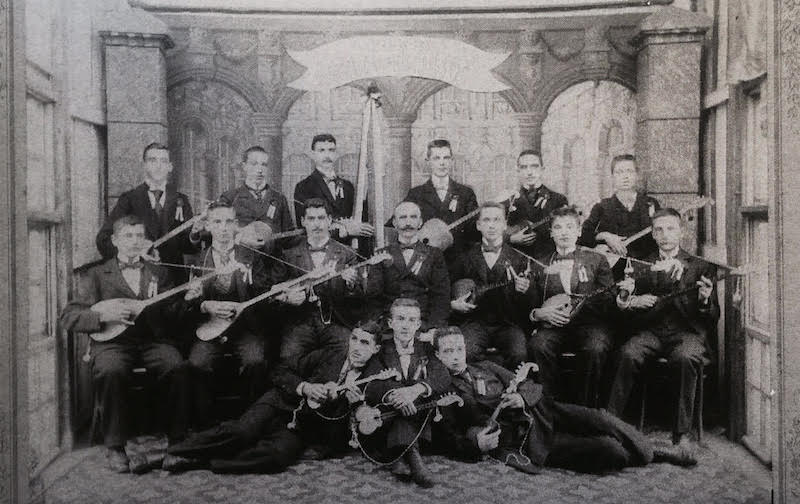
Gundulić tamburitza orchestra in Dubrovnik, arround 1898. Source [Miho Demović, Glazba i glazbenici
na području bivše Dubrovačke Republike za vrijeme austrijske uprave 1814.-1914., p 111].
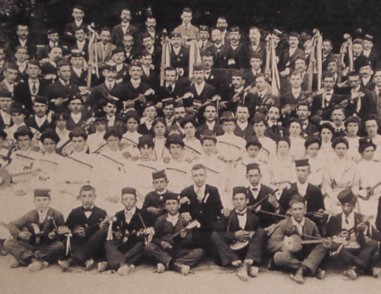
United choirs of the Kastav region near Rijeka, 1908
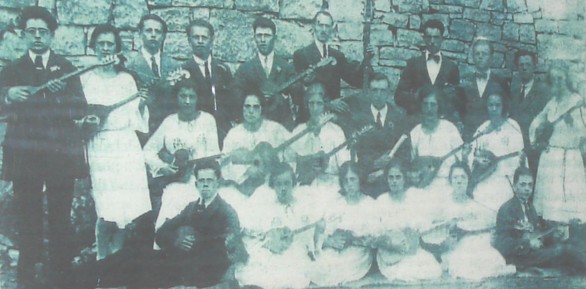
Tamburitza orchestra Spinčići in Kastav, 1922
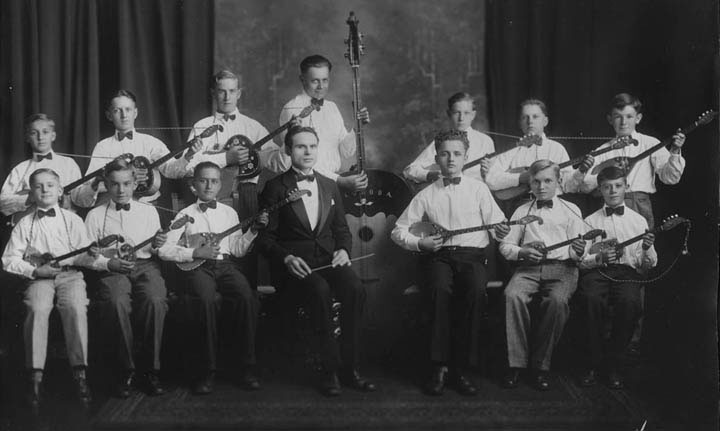 |
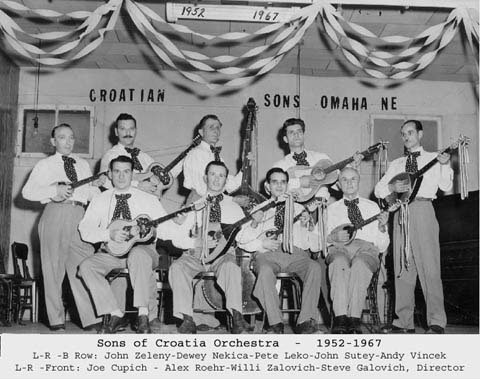 |
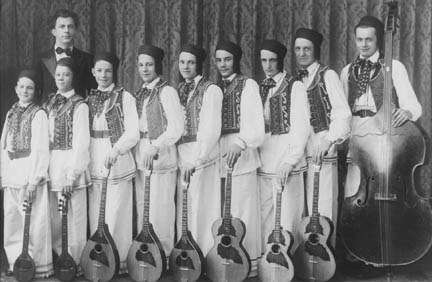 |
I know it would be a fatal mistake not to provide an example for the people from Dalmatia (they are quite sensitive). Here is a nice back-cycling:
C#7 -> F#m -> B7 -> E
Try to harmonize the rest of this exceptional song yourself.
S ponistre se vidi Šolta
text: Zdenko Runjić
music: Oliver Dragojević
E
Šoto voce piva klapa,
C#7 F#m
u to gluho litnje doba,
B7
i prolazi ispod skala
F#m B7 E
di se suši tvoja roba.
Do pergula riči lete,
tu se misec smije gradu.
Ti se dižeš iz kočeta,
da poslušaš serenadu.
C#7 F#m ...
S ponistre se vidi Šolta,
piva klapa ispod volta.
U daljini svitle koče,
piva klapa šoto voce.
Ti se ozireš po sobi,
slika je na kantunalu,
onceg ća ga more odni
u dalekem fortunalu.
Opustila davno riva,
zatvoreni su portuni.
Šoto voce klapa piva,
tvoji mirišu lancuni.
Tiho razmičeš koltrinu,
zrila si ka litnje voće,
o ljubavi i o vinu,
piva klapa šoto voce.
S ponistre se vidi Šolta,
piva klapa ispod volta.
U daljini svitle koće,
piva klapa šoto voce.
Niko neće te kaštigat,
kad bi skinila korotu.
Život che te svu deštigat,
A još moreš dat lipotu.
S ponistre se vidi Šolta,
žmiga svitlo ispod volta.
U po volta kada pasa,
piva klapa ispod glasa.
By the way, don't miss the following beautiful Dalmatian klapa songs web site. Chapeau! See also another klapa songs web site.
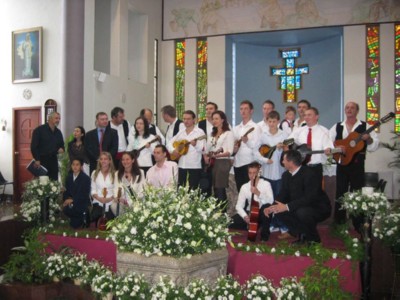
Tamburitza orchestra performing after Easter Mass 2006 in South Africa
(many thanks to Mr Ivo Lusic, Johannesburg)
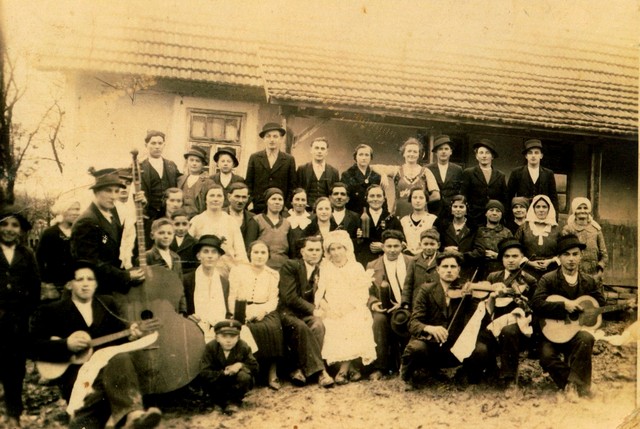
Wedding in the village of Samarica, Moslavina, North of Croatia
Tamburitza orchestra in the Croatian reading room in 1908 in Bugojno, Bosnia and Herzegovina.
Source Antun Lučić ed.: S Napretkom kroz stoljeće 1906.-2006., HKD Napredak, Bugojno 2006. ISBN 978-9958-9134-0-2
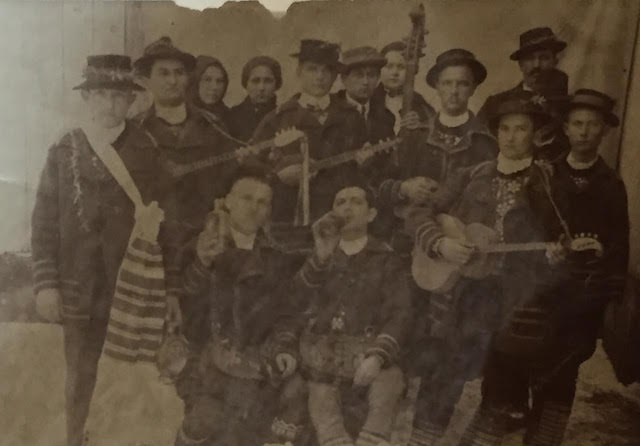
Tamburica orchestra in the town of Županja, from the beginning of the 20th century.
The further step in harmonization would be to describe possible alterations within the same (constant) chord, which in fact leads to the jazz harmony. This can be applied even to such a simple song as:
Sinoć kad sam ti proša
A Aj7 A6 Aj7which sounds very nice. Here Aj7 stands for Amaj7. Note the back-cycling here too, which is essentially:
Sinoć kad sam ti proša,
A Aj7 F#7 Bm E
mimo te bile dvore vidim te dušo Mare.
D E
Vidim te dušo Mare,
E7 A
di s drugim govoriš.
....
F#7 -> Bm -> E -> E
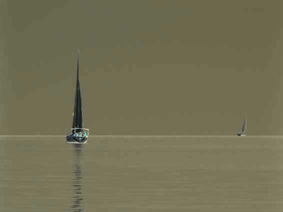
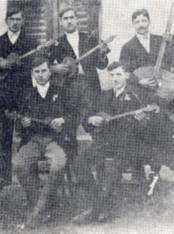
Tamburitza orchestra conducted by left-handed player Antun Kranjec,
Molve 1918 [Ivancan, p. 196]
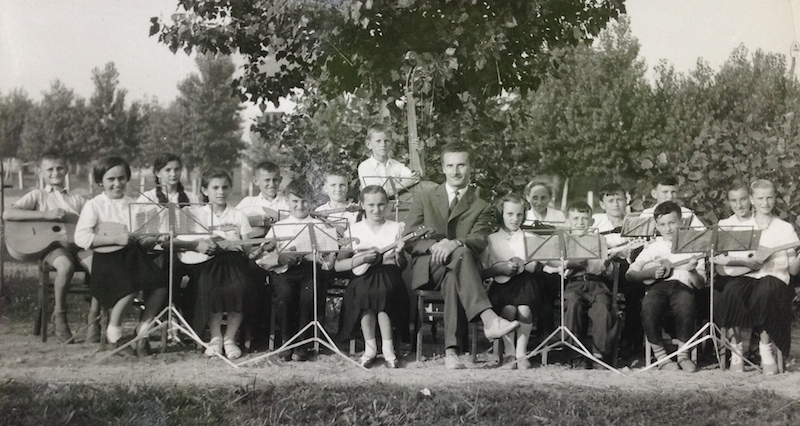
Dragutin Božić, schoolteacher with his class in Molve, 1961. Music instruments produced by the Kos family enterprise in Pitomača.
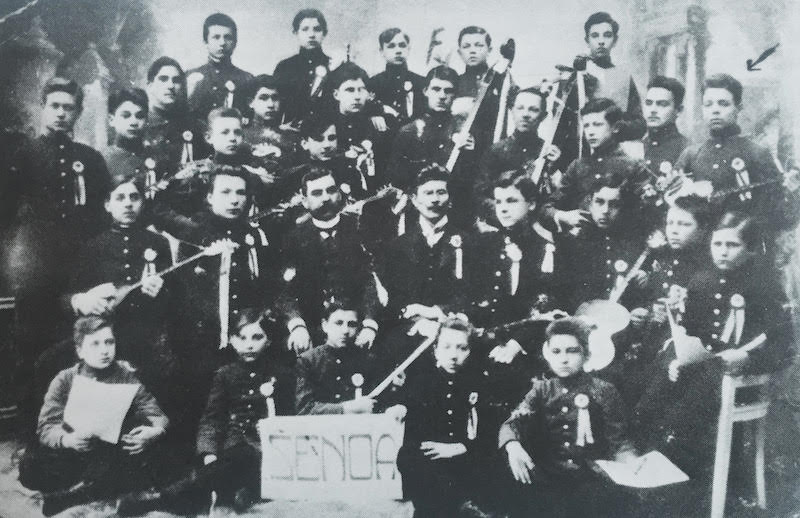
as a student of the Crafts School in Zagreb.

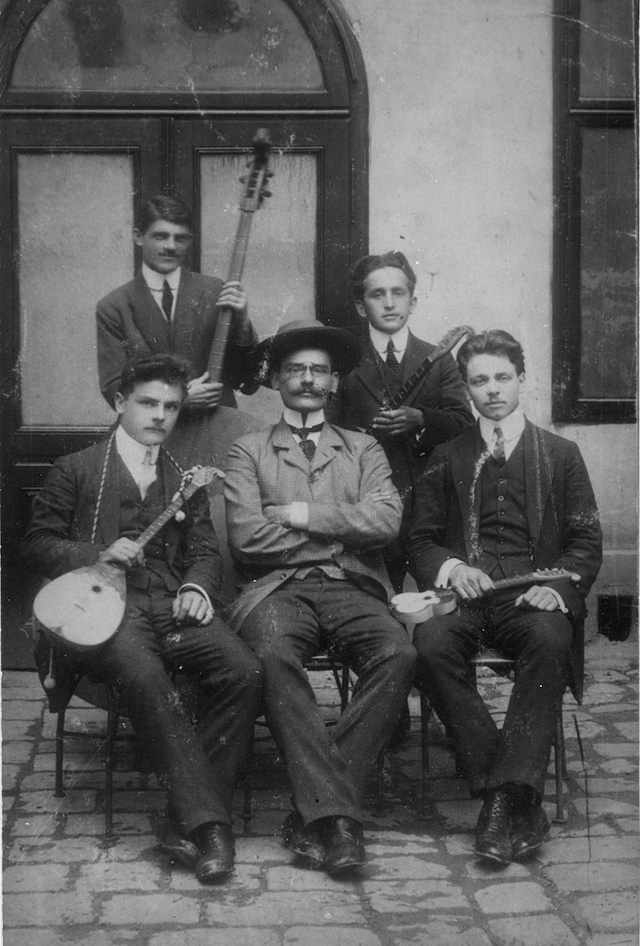
Rudolf Fizir with his bas among Croatian tamburitza players in Wiener Neustadt in Austria.
Of course, many songs do not `tolerate' excessive harmonization, which is probably the case with the above song too. Another `extreme' is for instance Vu plavem trnaci, a real (harmonic) challenge. I like this song very much.
Vu plavem trnaci
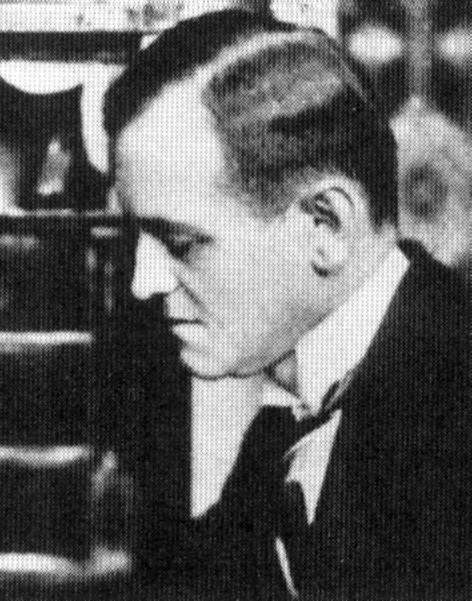
Gjuro Prejac (1870 - 1936)
G Gm AmD7 G
1. Vu plavem trnaci mi hiža stoji,
G D A7 D
od zelenih vejah je videti ni.
C D7 G Gm AmD7 G
Bogica je z'dreva, ne vufa se reva
G0 G Em Am D7 G
pokazat pred ljudmi kak da se boji.
Em Am B7 Em
Vre slaba je, stara prek stotinu let,
F# B F# B
od njezine brajde posušil se cvet.
Am B7 Am B7
Od blata je zbita, i škopom pokrita,
Am Em C B7
ne moreš prav znati je'l hiža il' klet.
Am D7 G Em
Nju muški su žuli prinesli na svet,
Am D7 G G7
za onda dok Zagorec bil je još kmet.
Am D7 C0 Em
I bila je bela, i z'mirom vesela, |
D#7 G Em AmD7 G | 2x
a danas od tuge se hoće podret. |
2. I vnogi se lajtić vu njoj je ispil,
plebanuš, vučitelj tu vinček je pil!
Z gosponom pogaču i orehovnjaču
je mužek rad drobil i srećen je bil.
Pod malim oblčcekom fantić je stal,
prelubleno dekle potiho je zval.
I vnogi je pušlec zamenil za kušlec,
i morti je fantić v komori i spal.
V toj hiži se rodil je vnogi vojak,
i vsaki je sledni bil pravi junak!
Za tujca vojeval i krv je proleval,
za falu su rekli mu da je bedak!
3. I hižica tiha ščekuje on čas,
kad jenkrat i Zagorcu došel bu spas!
Na oko je tiha, al veter zmir njiha,
vu vejah šumechih starinski jen glas:
em Zagorcu samo je Zagorje raj,
nigdar nebu zabil govoriti kaj.
Dok krv je proleval on zmir je popeval:
Še jenkrat bi rad videl zagorski kraj!
Pretrpel je muke črez jezero let,
al zopet bu brajda potirala cvet.
Iz našega gorja vre javla se zorja,
vesela i srećna bu hizza i klet!
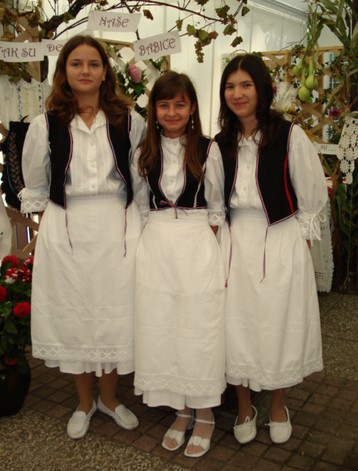
Milan Grakalić (Medulin, 1909 - 1979), an excellent Croatian guitarist (and architect), has arranged Vu plavem trnaci for classical guitar, see the scores. For more details see Andrija Tomasek: "Vu plavem trnaci", Matis d.o.o. Pregrada, 2005, ISBN: 953-96561-9-2. Many thanks to Professor Tomasek for scores.
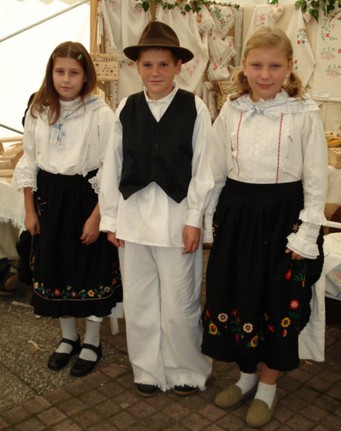
When you visit the castle of Veliki Tabor, don't miss to see the room devoted to Gjuro Prejac, who was born in the nearby village of Desinic.
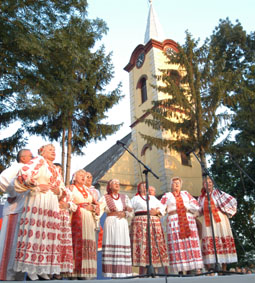
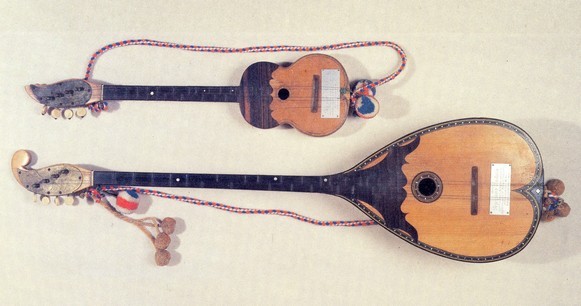
Tamburitzas of Stjepan Radic, source [Tomicic]
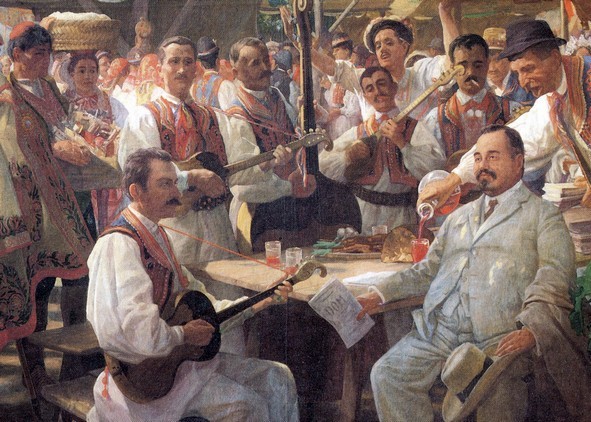
Stjepan Radic with Croatian peasants in Zagreb, source [Tomicic]
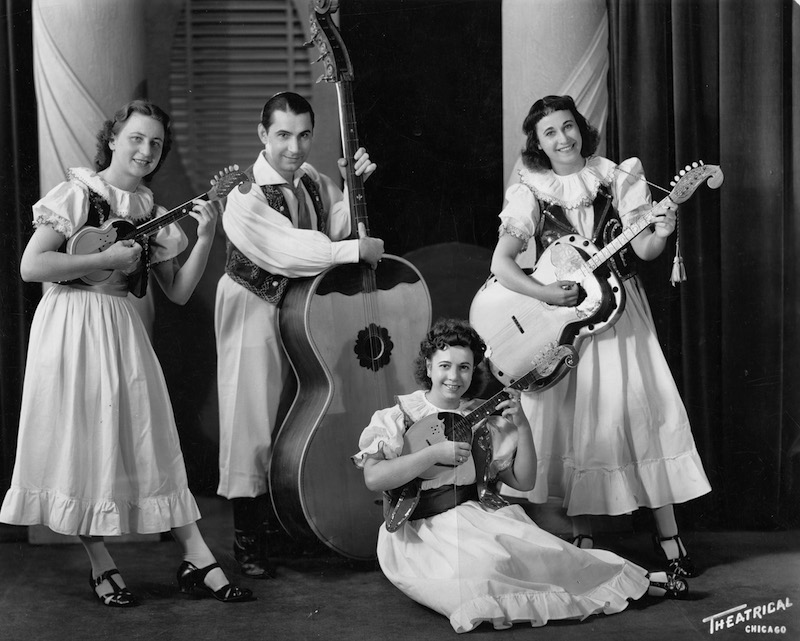
The Elias Tamburitzans, also known as the Croatian Tamburitza Ensemble, existing probably between the two World Wars. Left to Right: Martha Elias, Charles Elias, Mary Filipovich, Anne Elias. Source: Helene Stratman-Thomas Collection, Mills Music Library, University of Wisconsin-Madison. See James P. Leary and Folksongs of Another America.
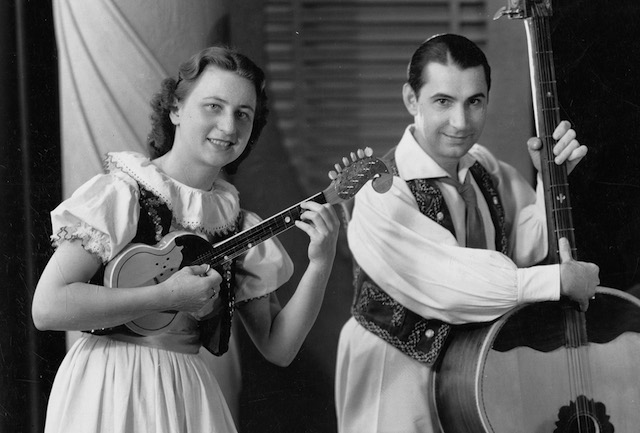

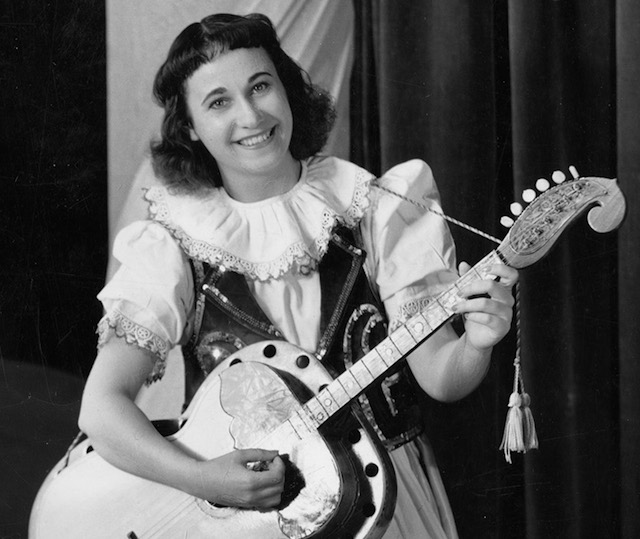
The accompaniment of the following very nice song can be also be ``sprinkled' with back-cycling: Em -> A7 -> D, or B7 -> Em -> A7 -> D.
Oj, jesenske duge noći
Ivan Trnski
D Em A7 DIn the third line you may also use back-cycling:
Oj, jesenske duge noći, oj!
D B7 Em A7
Oj, jesenske duge noći,
D A7 D
reko dragi da će dochi, oj!
D A7 D
Čuj me dragi čuj!
(repeat last three lines)
....
D Bm Em A7 D
reko dragi da će doći, oj!
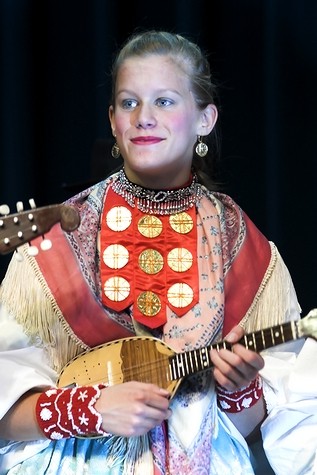
CroatiaFest 2005, Seattle, USA, Photo - Jal Schrof
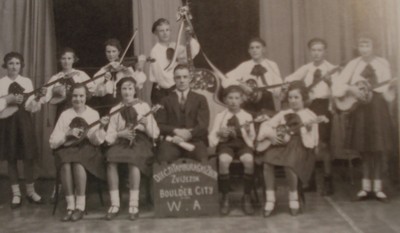
Children's tamburica orchestra Zvijezda (Star) in Boulder City, Western Australia, 1936, see [Sutalo]
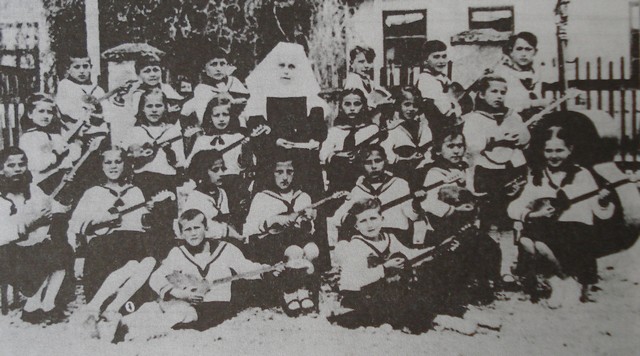
Tamburitza orchestra in Bugojno, Bosnia and Herzegovina, in the first half of 20th century, directed by a nun.
Note that there are many girls. Source [Antun Lučić ed.]
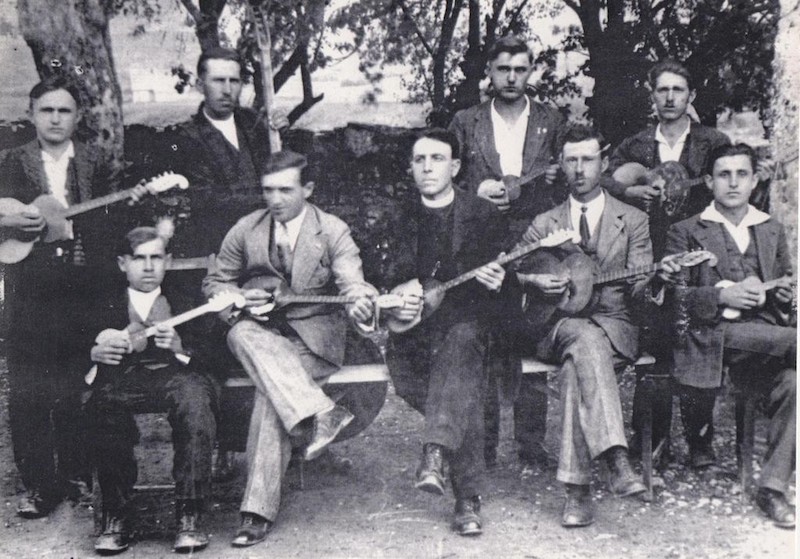
Saborsko tamburitza orchestra in 1930s, Gorski Kotar, Croatia. Standing: Ivan Špehar (Zec), Josip Grdić (Ćilim), Petar Sertić (Pera Mašin), Vuković Mate (Mateša). Sitting: Nikola Špehar, Slavko Katušin - teacher in Saborsko, Joso Vukelić - Catholic priest in Saborsko, Marko Grdić (Markica Josin), Pave Vuković (Maljićev). Source of the photo Saborčanski tamburaški zbor iz 30-tih godina prošlog stoljeća.
Ima jedna kućica
Text: Vinko Kos, music: Jakov Gotovac
A
Ima jedna kućica
D
draga srcu mom.
D E A
Ta kućica pod lipom |
E D (A) | 2x
stari je moj dom. |
U njoj živi majčica
dobar otac moj.
A i meni najljepše
živjet je u njoj.
Kućo draga kućice
čuvao te Bog,
jak i vjeran branitelj
starog doma mog.
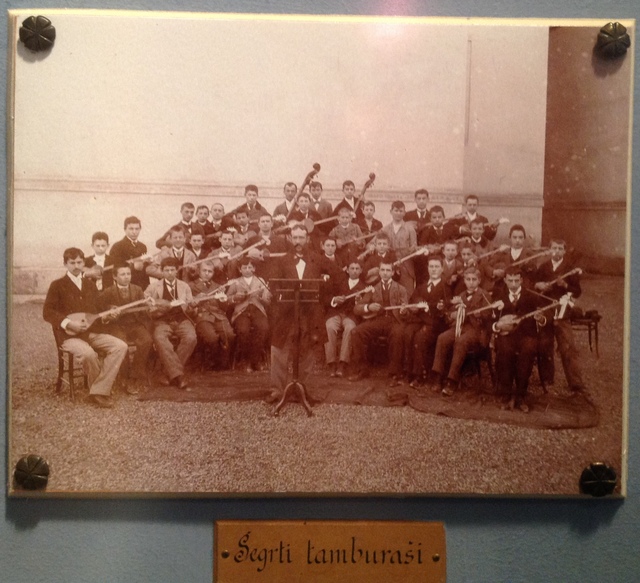
Photo of young Croatian entrepreneurs - Tamburitzans, exhibited in the Croatian School Museum (Hrvatski školski muzej) in Zagreb.
The photo is probably from approx. 1900.
Ova pjesma se u Hrvatskoj do godine 1945. pjevala na stari način. Nakon 1945. nije se smjela pjevati ili pojavljivati u knjigama u tom obliku (radi "čuvao te Bog"). Da bi pjesma bila spašena, unesena je preinaka u zadnjoj kitici. Složio ju je Velimir Žubrinić, učitelj i ravnatelj OŠ u Kozjaku, malom selu kod Krapine, zajedno sa svojom suprugom Katicom rođ. Suntešić:
Kućo draga kućice,mili dome moj,
bit će vjeran branitelj
tebi sinak tvoj.
Katica Suntešić je kao dijete tu pjesmu naučila godine 1942. od svoje učiteljice Štefice Rubin u osnovnoj školi u Svetom Križu Začretje (Štefica Rubin, židvoskog podrijetla, tragično je stradala 1943. prigodom partizanskog napada na vlak na putu za Zagreb). Usmenom predajom ta se inačica vrlo brzo proširila ne samo u Hrvatskoj, nego i izvan domovine, pa i među Hrvatima SAD-a koji znadu čini se samo ovu drugu inačicu.
Autori teksta i melodije izvorne pjesme nisu nam poznati. Sadržaj pjesme "Ima jedna kućica" nudi prekrasne motive za domoljublje i likovno izražavanje djece. Treba zahvaliti učiteljici Štefici Rubin što je djecu u školi učila tu pjesmu, te roditeljima Katice Suntešić, Barici i Petru, koji su joj usadili ljubav prema pjesmi. Zanimljivo je da se obje inačice navode u knjizi [Duša narodna], na str. 51 i 88.
O toj pjesmi govori istaknuta hrvatska pjevačica Lada Kos u filmu Neprijatelj naroda redateljice Višnje Starešine. Test pjesme je napisao njezin otac Vinko Kos (1914.-1945.), koji je stradao na Križnom putu.
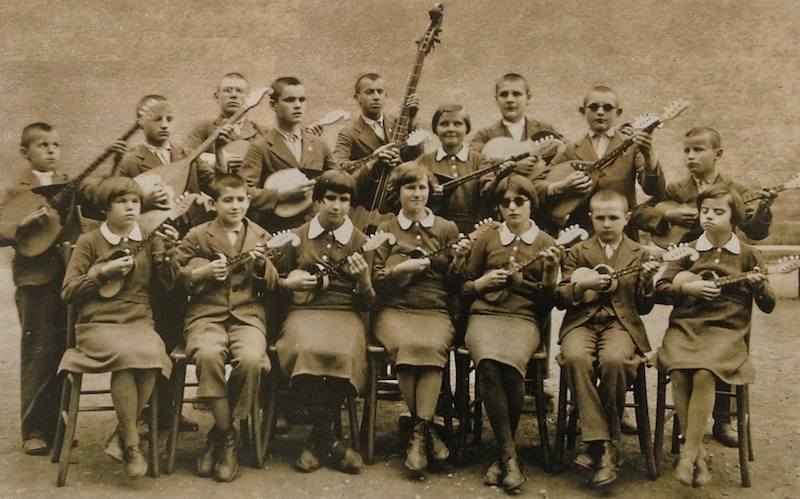
Blind tamburitza players in Zagreb, from the School "Vinko Bek" for blind children. Photo from arround 1920.
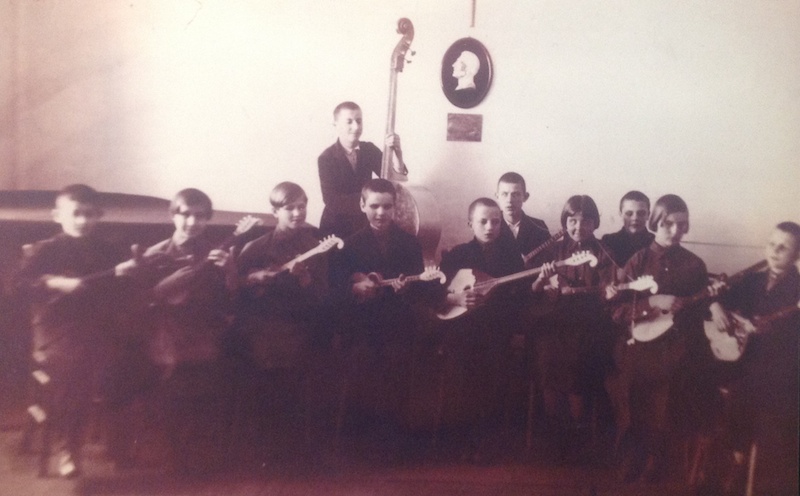
Blind tamburitza players from the School "Vinko Bek" for blind children. Photo from arround 1920,
exhibited in the Typhlological Museum in Zagreb.
Kad se Tena udavala
G B7
1. Kad se Tena udavala,
C D7 G
od čaše se nisam mako.
G B7
žalio sam sudbu svoju,
C D7 G
Danima sam stalno plako.
Refrain (2x):
G B7 C
Udaše mi moju Tenu,
Am D7 G
Doveli i tamburaše,
G E7 Am
Meni osta samo želja
Am D7 G
I neispijene čaše.
2. Majka vicce: Što si bisan,
zašto konje tučeš sine?
Pa i drugih cura ima,
sve su lipe sve su fine.
2xR.
Many thanks to Mr. Darko Varga for having contributed nice photos representing national costumes from the village of Draz (Baranja near Danube river).

Ivanovci, Slavonija, Croatia, from the blessing ceremony of installing two church bells made in Innsbruck, Austria, 2006.
The ceremony has been led by bishop Marin Srakić, born in that village.
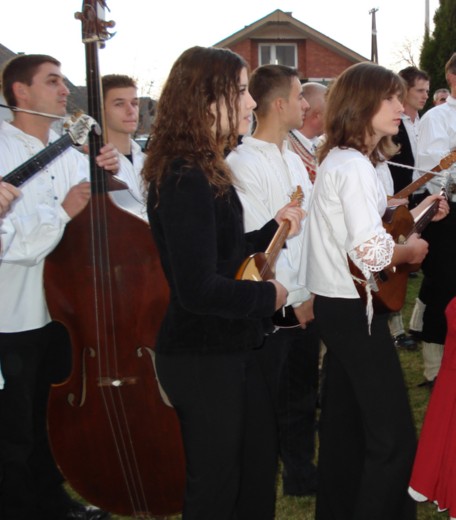 | 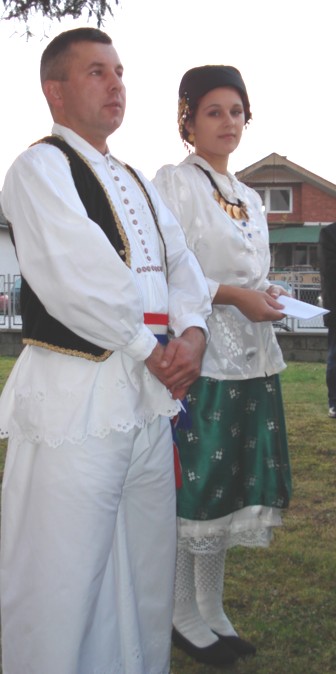 |
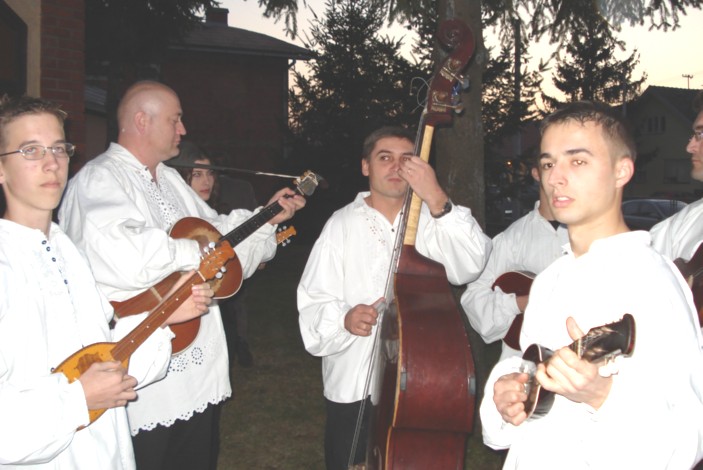
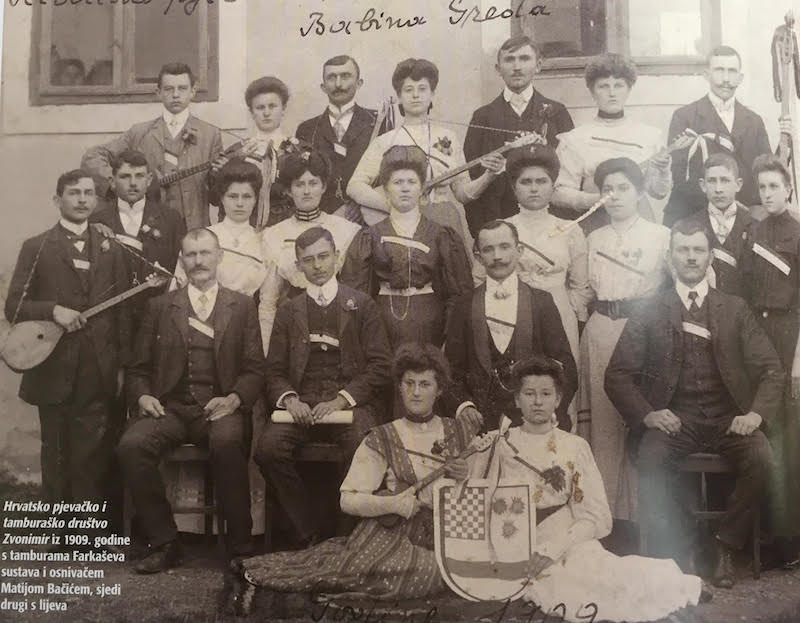
Hrvatsko pjevačko tamburaško društvo "Zvonimir", Babina Greda, 1909. (Croatian singing and tamburitza society "Zvonimir", from Babina Greda, 1909). Source Mihael Ferić: Hrvatski tamburaški brevijar / The Croatian Tambura Breviary, Šokadija, Zagreb, 2011., fascinating book with 1300 photos on 500 pp. Two girls are sitting by the Croatian Coat of Arms.
Please, go to the next page below.
Uzalud vam trud sviračiPrljavo kazalište
Bm Em
S onu stranu PliveTraditional song of Bosnian CroatsD A
Another song by Zvonko Bogdan written in the sweet Croatian ikavian dialect. PIVAJTE PISME BUNJEVAČKE! Hej, salašiZvonko BogdanA E E7 A The melody of the song Fijaker stari, for which Zvonko Bogdan wrote verses, is known in Croatia for very long, at least from the beginning of 20th century. Indeed, Bogdan has taken the melody of an old Croatian song Zrtva ljubavi, known at least from the beginning of the 20th century. I owe this information to Dunja Knebl, well known interpreter of old, forgotten Croatian songs, in particular from Međimurje.
Those wishing to learn more about the history of Bačka Croats (Bunjevci and Šokci) may consult the following books written by Ante Sekulich (born in Backa):
Kolo igra, tamburica sviraverses by N. Kujundžić, music by S. MukićD A DOne of the greatest tamburitza players among Backa Croats was Pere Tumbas - Hajo (Bunjevac, dika Bacckih Hrvata iz bile Subotice).
Kraj kapele sv. AneMarko Vukasović, Stojdraga, Žumberak
Dm Gm Kapela sv. Ane is near the town of Samobor.
Sidi Mara na kamen studencuTraditional Croatian song from SrijemEm Am B7vincu = vinac (vijenac) = here has the meaning of prayer-book (molitvenik) It is little known that this very old and popular Croatian song was originally sung in IKAVIAN dialect. Here we present its version from the city of Subotica, as the Bunjevci Croats used to sing until mid 20th century. I learned this from older people from Subotica, whose grandparents sang it like this. ĂĂĂĂĂĂĂÂ
It seems that "Sidi Mara..." is therigin for the melody of ALOHA OE (Farewell to Thee), famous Hawaiian song and the national anthem of Hawaii. Its words were written by Her Majesty Queen Liliuokalani around 1877. Possible Croatian origin for the melody of ALOHA OE is indicated in an article written by John Berger in HAWAII MAGAZINE, August 1996, p. 41. Very close relation between the melody of "Sidi Mara..." and ALOHA OE has been indicated by Branimir Vidmar, Timmins, Ontario, Canada, 1978. Vidmar also indicated that the melody is close to American gospel "How Great Thou Art," composed by K. Hine. It is also worth noting that "Sidi Mara..." has Austro-German version called Die Träne, and the English version is The Tear (this can also be seen from Vidmar's sheet music). As stated in Ripley's Believe it or not, Hawaiian music is the creation of a German bandmaster captain Henry Berger (1844-1929), invited to Hawaii by King Kamehameha V in 1872. Berger composed the first Hawaiian songs which "he adapted from German folk tunes." He composed 72 famous Hawaiian songs, including ALOHA OE and the Hawaiian national song. We can be pretty sure that the "German tune" adapted to Hawaiian ALOHA OE was in fact Croatian song "Sidi Mara...", which Berger obviously knew as "Die Träne." Very beautiful and original type of songs among Bunjevci Croats in Bačka are the so called groktalice. They are very emotional, sung slowly in a trembling voice, without any instrumental accompaniment.
Here is a well known children's verse from Subotica, as older people still remember: Eci, peci, pec, Note "pripelica" instead of "vjeverica"! Veliko je moreTraditional Croatian songA U dubini njemu Po njem bijela lađa Na žalu su djeca, I learned this song from my mother Katica Žubrinić b. Suntešić, and she learned it in 1942 from her school-teacher Štefica Rubin in Sveti Križ Začretje.
ZAPIVAJ PISMU RIBARU STARI! Ribar plete mrižu svojuTraditional Croatian songD G D
VILA VELEBITAA E
If you want to create excellent atmosphere at a birthday party, I suggest you the following very attractive traditional song from the north of Croatia, with fantastic music and verses:
|
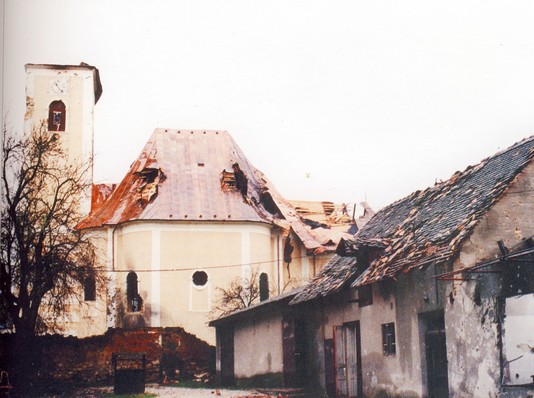 | 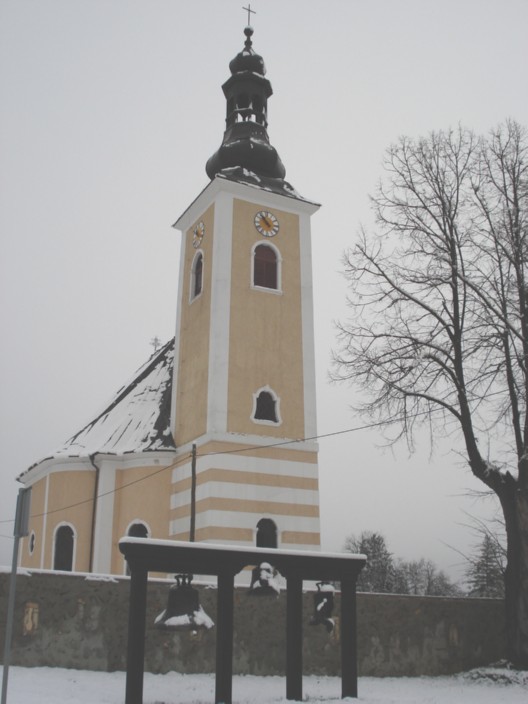 |
... in their ruined church on the left. Reproduced from [Pokupsko], many thanks to Mr. Božidar Škrinjarić for permission. On the right is the renovated church (2007), with three shattered bells in front of it, destroyed during the Greater Serbian agression in 1991.
I hope that with these few musical examples I managed to convince You in the usefulness of back-cycling and parallel chords. You will hear them very often on recorded materials on the radio and elsewhere (just listen carefully). I assure you that Croatian folk provides an amazing amount of examples for many interesting harmonic mechanisms! If you don't believe, look at:
Međimurske narodne pjesme
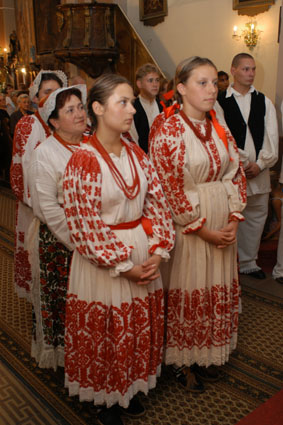
More details can be found in my booklet ``Gitara za radoznalce' (some libraries in Zagreb possess it). For those interested I must say that at this moment it is not available.
Remark In the literature you will see the song ``Oj, jesenske duge noći' sometimes attributed to Branko Radičević, which is wrong (this error appears in my booklet as well!) - the author is Ivan Trnski, a Croatian poet.
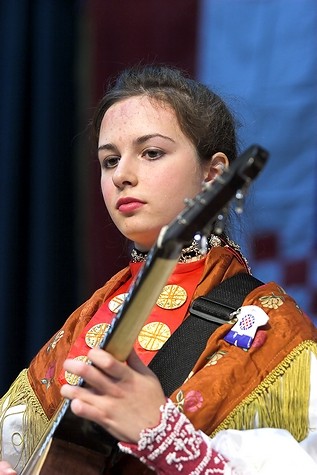
CroatiaFest 2005, Seattle, USA, Photo - Jal Schrof
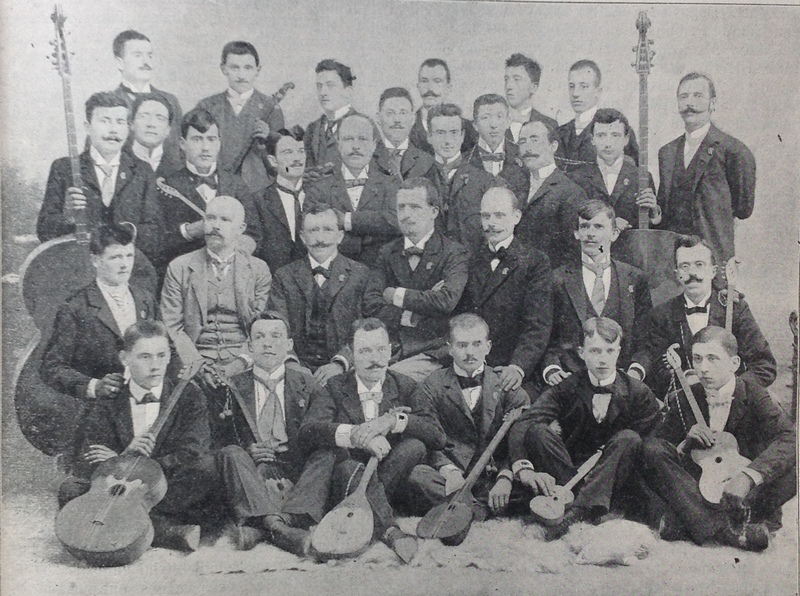
Singing and tamburitza society Laurel (Pjevačko i tamburaško društvo Lovor) from Opatija, not later than 1907.
Veliki Ćirilo-Metodski koledar za 1907., str. 85
A final remark (with best intentions): The Institute of Folklore in Zagreb possesses an extremely valuable collection of more than 2000 folk songs collected mostly among the Croats in Baccka and Srijem by dr. Josip Andrić (1894-1967). Unfortunately, they are still unpublished. Maybe this remark will be a necessary impetus to make this invaluable collection accessible to the wider audience, especially to those youngsters playing tamburitza. Our national instrument is an object of the study on the Academy of Music in Zagreb, similarly as done by other nations having their own national instruments.
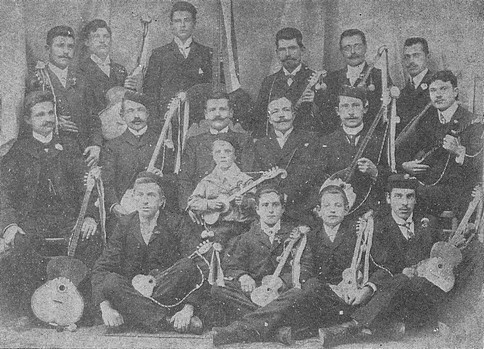
Croats in Punta Arenas, Chile (Magallanes region), with their tamburitzas
Croatian tamburitza band Tomislav in Punta Arenas, 1905
Hrvatsko tamburasko društvo Tomislav, Punta Arenas, 1905
(photo from Lj. Antić, Hrvati u J. Americi, Zagreb, 1991, pp 182 and 266)
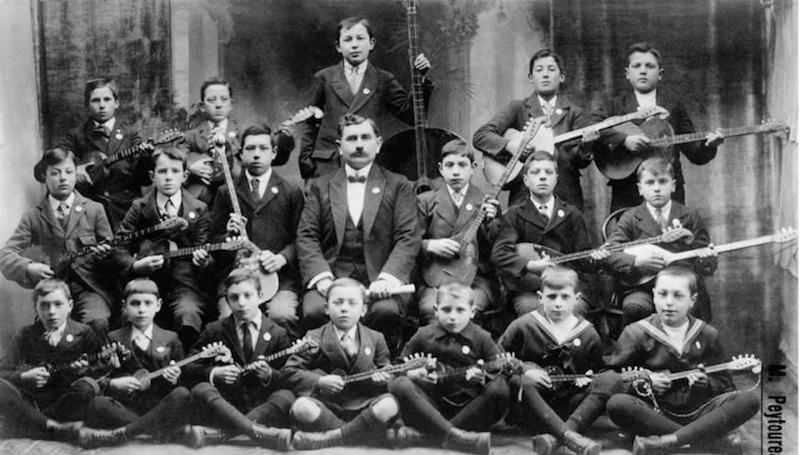
Hrvatsko tamburaško društvo Tomislav (Croatian tamburitza band Tomislav), Punta Arenas, Chile, 1916.
The most beautiful book I know, devoted to the thorough treatment of Croatian folk songs in Croatia as well as in Bosnia and Herzegovina and Serbia, comprising excellent photos of various dances and national costumes, is
dr. Vinko Žganec: Hrvatske narodne pjesme (Croatian folk songs)
published by Seljačka sloga, Zagreb 1951, with the parallel text in English. I saw it (to my greatest surprise) for the first time in May 1995. I suspect it was simply removed from our libraries in the fifties, for the reasons we can easily guess. Vinko Žganec collected more than 25,000 songs, among them 15,000 from his native Međimurje.
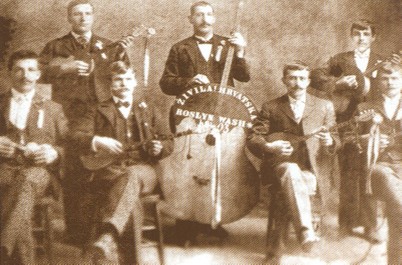
Tamburitza orchestra "Zivila Hrvatska" (Long Live Croatia), USA,
performed in White House for president F. Roosewelt in 1900.
I would recommend the reader an excellent book by Mr. Leopold, with a short history of tamburitza and accompanied with many Croatian folk songs, as well as some other references:
- Mihael Ferić:
- Zasvirajte tambure 1, 2, Kulturni centar Gatalinka, Vinkovci, 2002 and 2003, ISBN:953-98989-1-9 and ISBN 953-98989-2-7 repectively
- Hrvatski tamburaški brevijar / The Croatian Tambura Breviary, Šokadija, Zagreb, 2011., fascinating book with 1300 photos on 500 pp.
- Siniša Leopold: Tambura u Hrvata, Golden marketing, Zagreb, 1995; for those wishing to know more about tamburitza play see
- Željko Bradić, Siniša Leopold: Skola za tamburicu, 2, kvartnog sustava, udzbenik za 1. i 2. razred osn. gl. skole, Skolska knjiga 92.
- Stipan Krekić: Tamburaška početnica, 84 str., Croatica, Budimpešta, 2003.
- Mate Kliković, Feri Sučić: Zajačimo si : zbirka najobljubljenijih hrvatskih jačak - 4. izd. s notami. - Željezno: Hrvatsko kulturno društvo u Gradišću - Kroatischer Kulturverein im Burgenland, 2003. - 159 str.
- Michael Savor: The Tamburitza and the preservation of Croatian folk music, on this web.
- Kolar, Walter W.: An Introduction to Croatian Musical Folklore, (Tamburitza) Pittsburgh, PA 1981
- Ivan Ivančan: Narodni plesni običaji Podravine 1., Kulturno-prosvjetni sabor Hrvatske, Zagreb 1989.
- Slavica i Lana Moslavac: Kad zasvira lane moje, Pjesme i plesovi Moslavine i hrvatske Posavine, Muzej Moslavine Kutina, Kutina 2007.,
ISMN M-9013596-0-4 - Slavko Topić, Niko Luburić: Duša naroda, Svjetlo riječi, Sarajevo - Zagreb, 2007., ISBN 978-953-7091-41-5
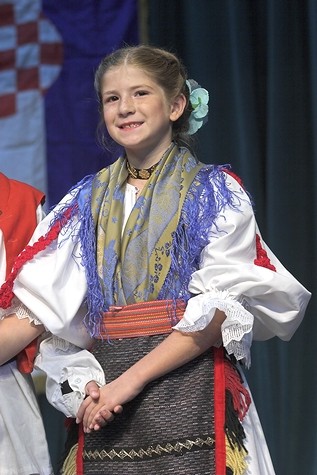
CroatiaFest 2005, Seattle, USA, Photo - Jal Schrof
Tamburica links in Austria:
- www.tamburica.at, by Kristijan Karall
- Tamburaski Orkestar i zbor Pinkovac
- Krostischer Musikverein Tamburica, Hrvatsko glazbeno drustvo Tamburica, Voralberg
Tamburitza music in the USA:
- Croatian Fraternal Union (has 35 junior tamburitza ensembles!)
- www.sidromusic.com
For further information (sheet music, collections etc.) please contact:
- Muzička naklada, Zagreb, Nikole Tesle 10, Zagreb, tel. (+385-1) 481 14 41. Musical instruments.
- LADO
- Savez glazbeno-estradnih umjetnika izvođača Hrvatske, Zagreb, fax 01/445716,
- Školska knjiga.
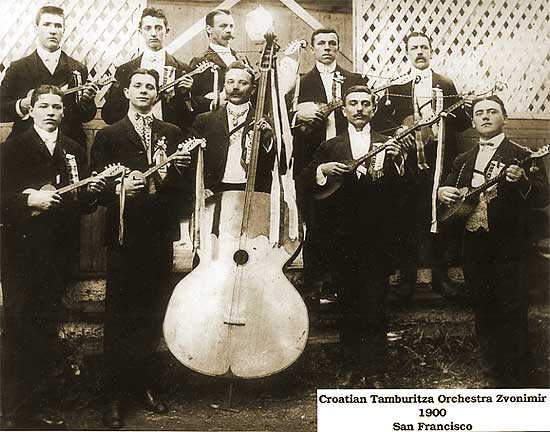
Croatian Tamburitza Orchestra Zvonimir, 1900, San Francisco, USA,
photo from Croatian American Web
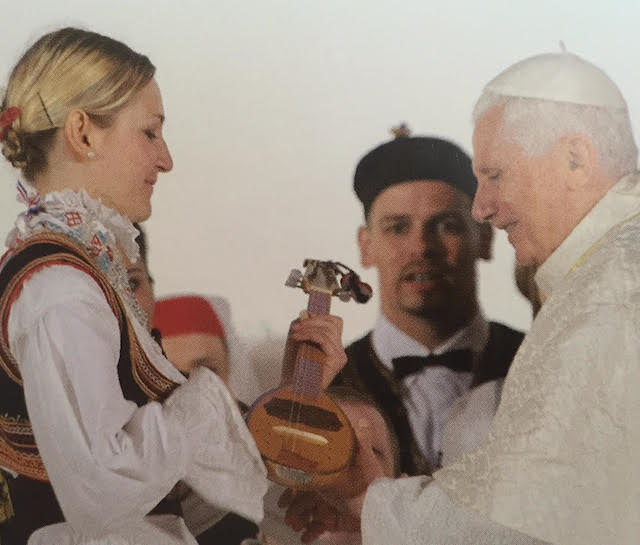
Tamburiza made by Andrija Franić from Županja, donated to Pope Benedict XVI
during his apostolic visit to Croatia in 2011.
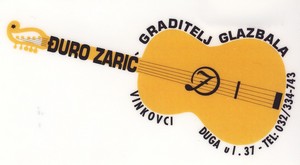
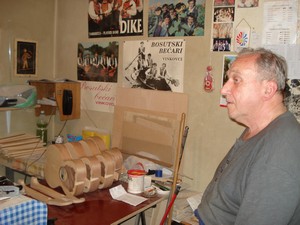
Mr. Đuro Zarić, Vinkovci, builder of tamburitzas
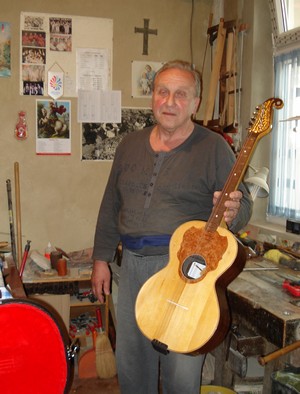
We would like to provide several addresses for those wishing to buy top quality tambura instruments (bisernica, prim, brač, bas prim, bugarija, čelo, bas):
- Djuro Zarić, Vinkovci, Duga ul. 37, tel. +385 32 334 743
- G. Tatić, Osijek, Kneza Borne 85, tel. +385 54 163 606 (prim)
- Nikolić Ilija, Osijek, Medulinska 20, tel. + 385 54 557 224 (brac = bas-prim)
- Marinko Katulić, Croatia - 10417 Busevec, Novo Selo bb, tel. +385 1 765 238
- Ivan Djuretić, Velika Gorica, tel. +385 1 714 385
- Postojnski Stanko, Srebrnjak 109, Zagreb (metal strings for all tambura instruments)
- Mr Kos, Pitomača.
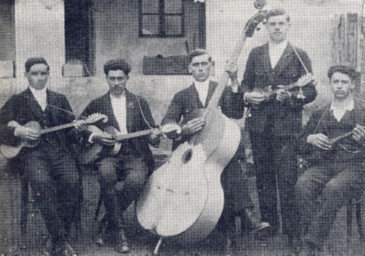
Tomo Kos, a well known builder of tamburas,
with his band from Pitomača, 1924 [Ivančan, p. 177]
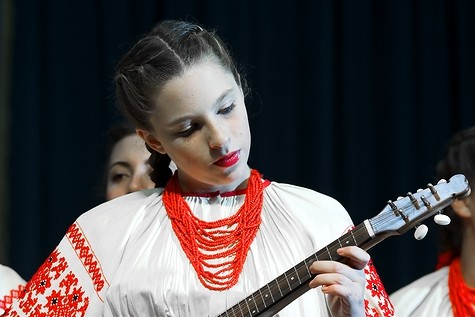
CroatiaFest 2005, Seattle, USA, Photo - Jal Schrof
Branimir Kvartuč: Đakovački vezovi (Đakovo Embroidery)
- Croatian music
- Međimurske narodne pjesme
- Chords for Croatian Christmas songs
- MUZEJ TAMBURE, Brod
- Brodsko posavski vremeplov tambure
- Preservation of music tradition in Moslavina Croatia
- Stjepan Veckovic founder of Croatian Bagpipe Orchestra
- Tamburaski orkestar "dr. Antuna Barca", Grizane, Vinodol, Croatia
- Tekstovi mnogobrojnih hrvatskih narodnih pjesama
- The largest collection of Croatian songs on internet
- Planinarska pjesmarica
- CROATIAN TAMBURICA ORCHESTRA, Tingley Chautauqau, 1917, USA
Damir Mihokovic - Miki's funeral in Zagreb accompanied with 300 Croatian tamburitza players
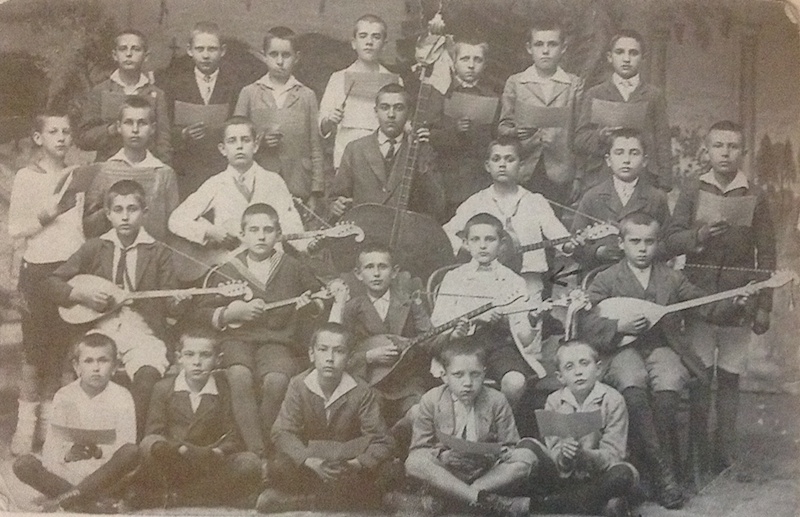
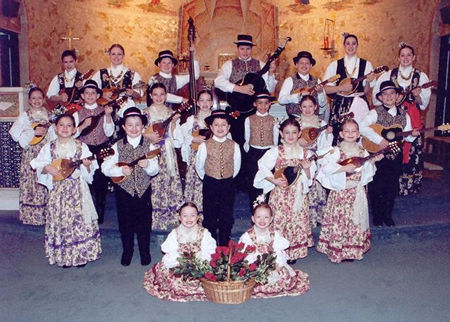
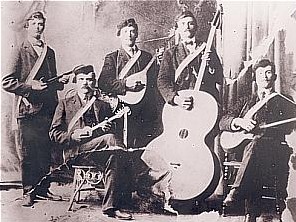

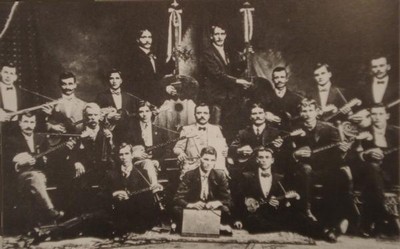
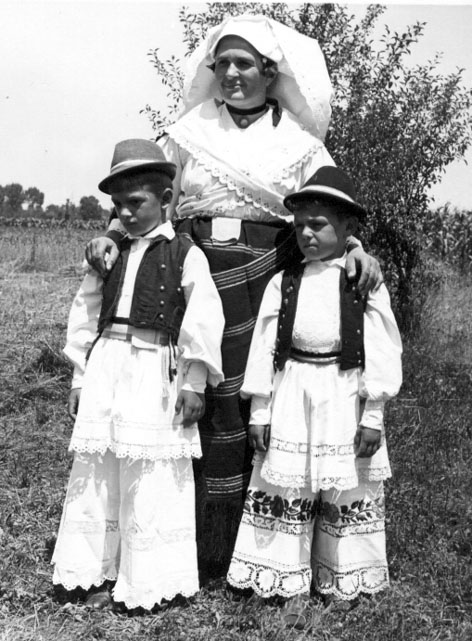 Miroslav Škoro
Miroslav Škoro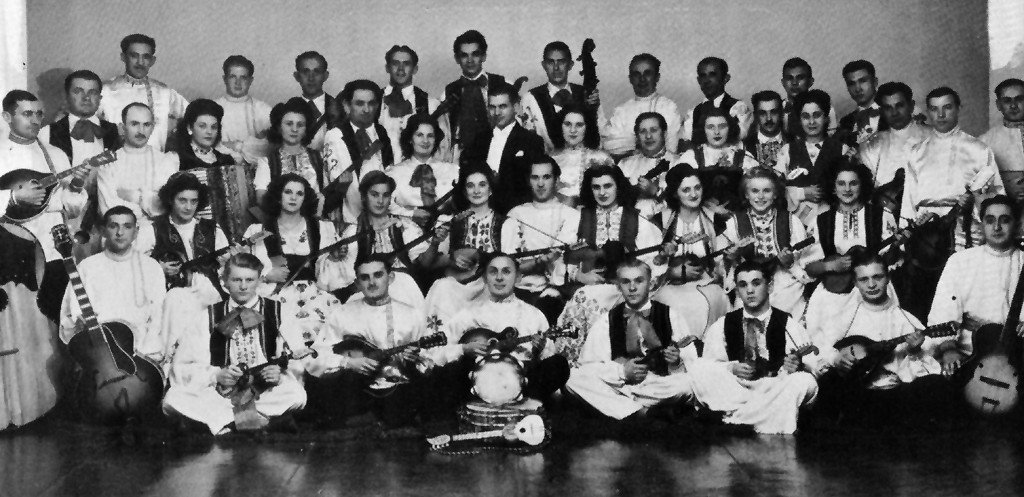
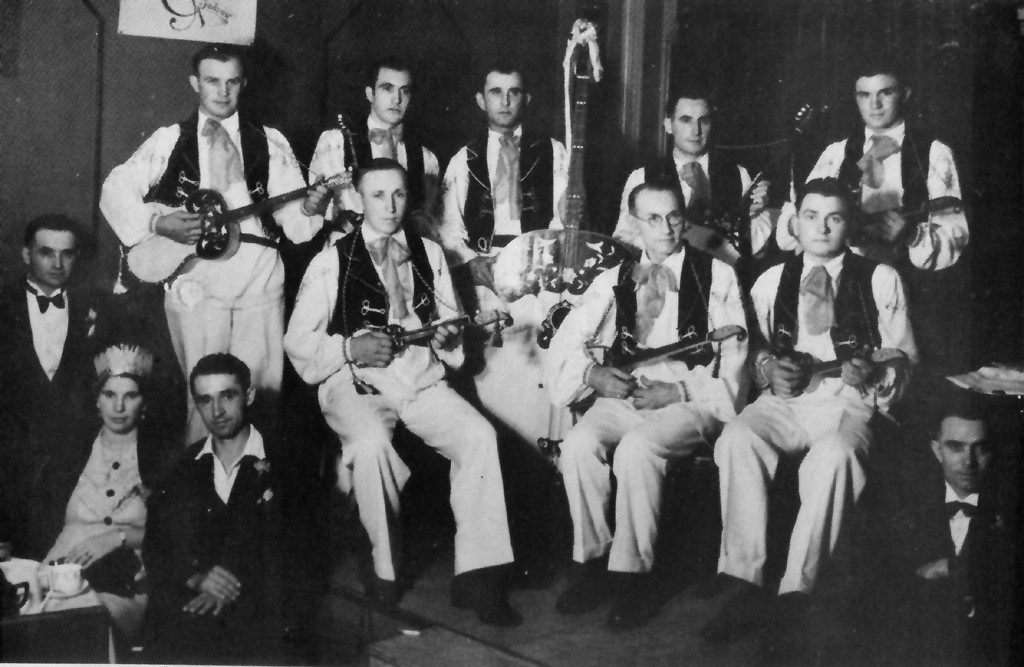
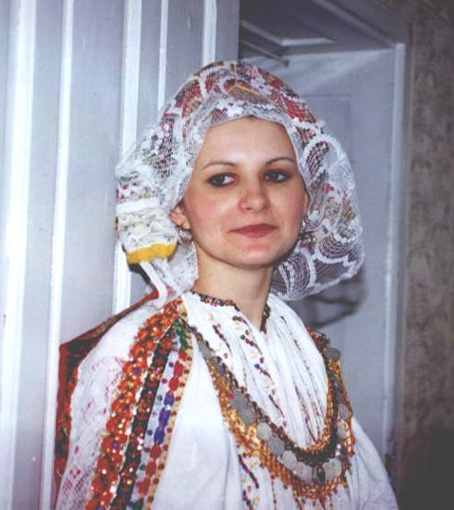 Let us give a simple, practical definition of the parallel minor corresponding to some major chord. I'll give a geometrical definition based on the cycle of fourths. If we start say with the G major chord on the cycle of fourths, then we go three steps BACK to obtain E(m). So Em is the parallel minor chord corresponding to G. Similarly, the parallel minor of C is Am, of D is Bm etc.
Let us give a simple, practical definition of the parallel minor corresponding to some major chord. I'll give a geometrical definition based on the cycle of fourths. If we start say with the G major chord on the cycle of fourths, then we go three steps BACK to obtain E(m). So Em is the parallel minor chord corresponding to G. Similarly, the parallel minor of C is Am, of D is Bm etc. 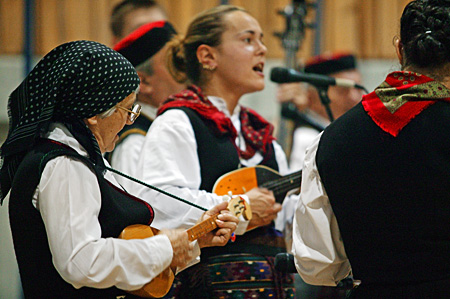

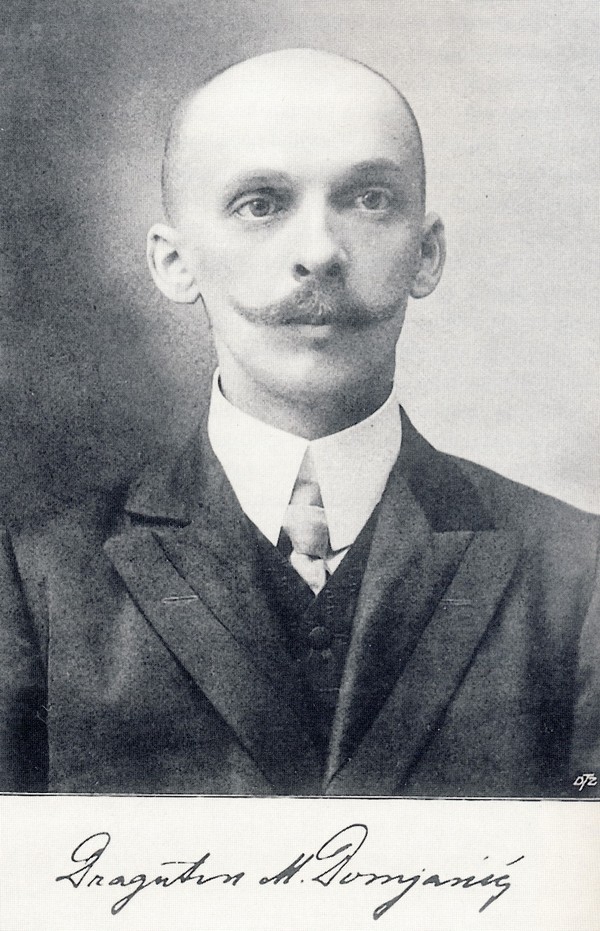
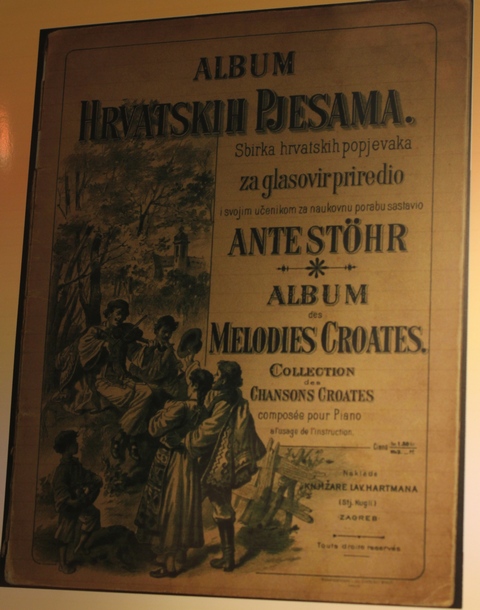
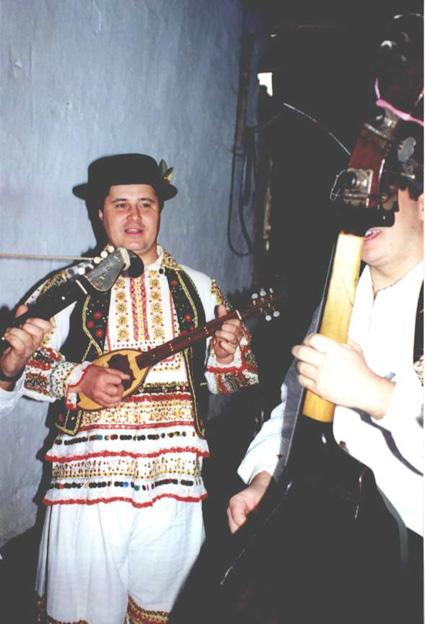
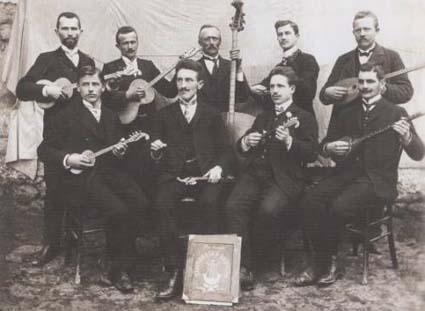
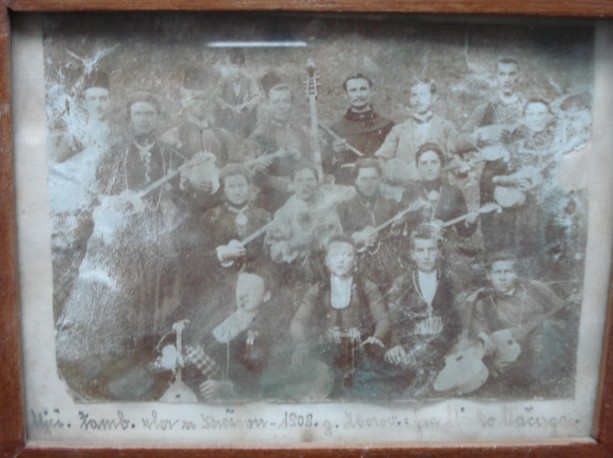
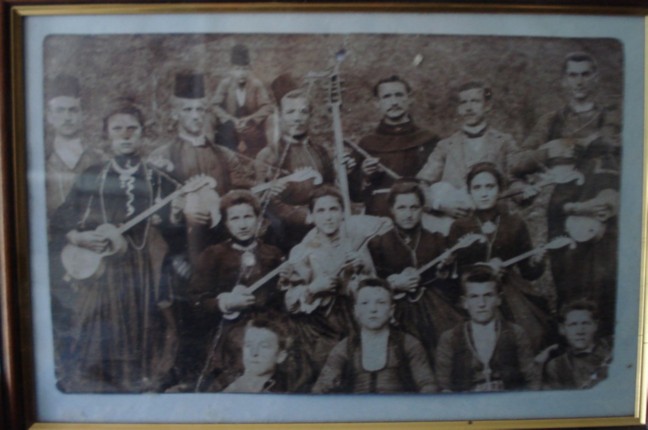
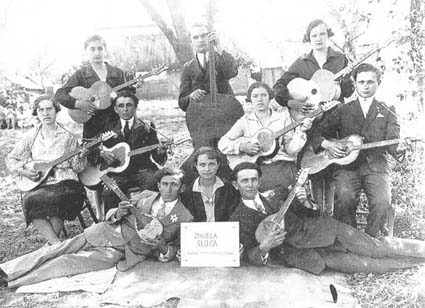
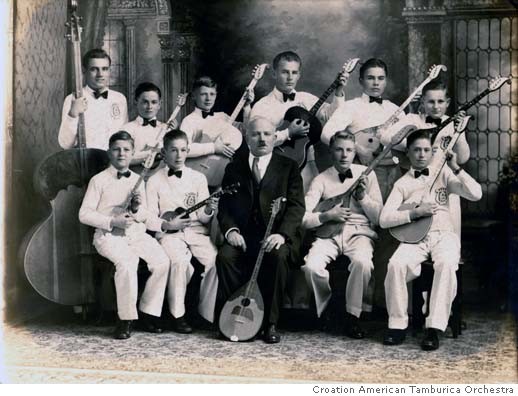
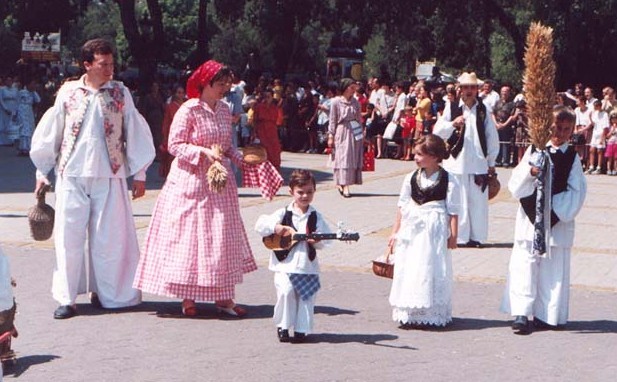
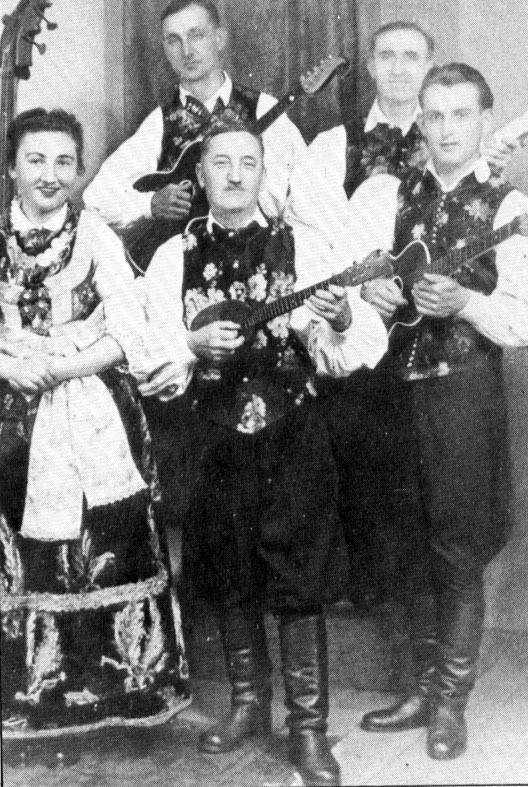
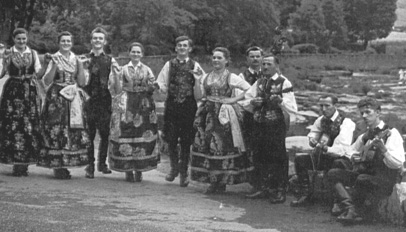
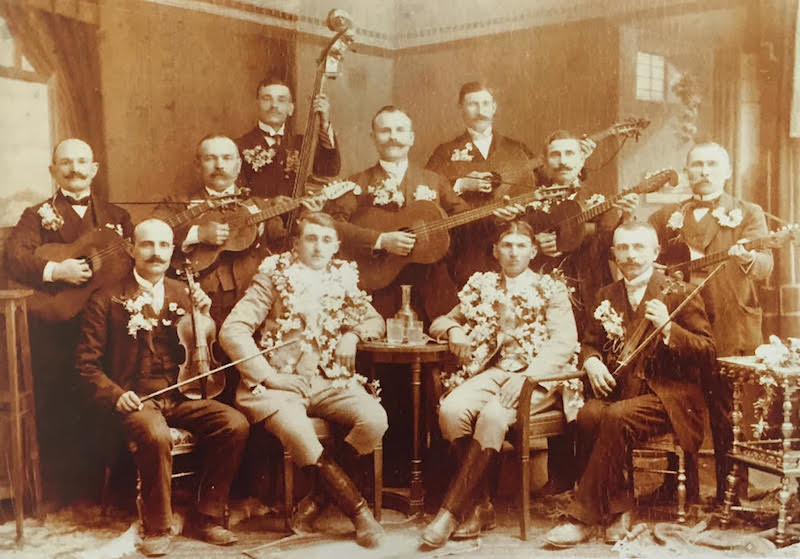
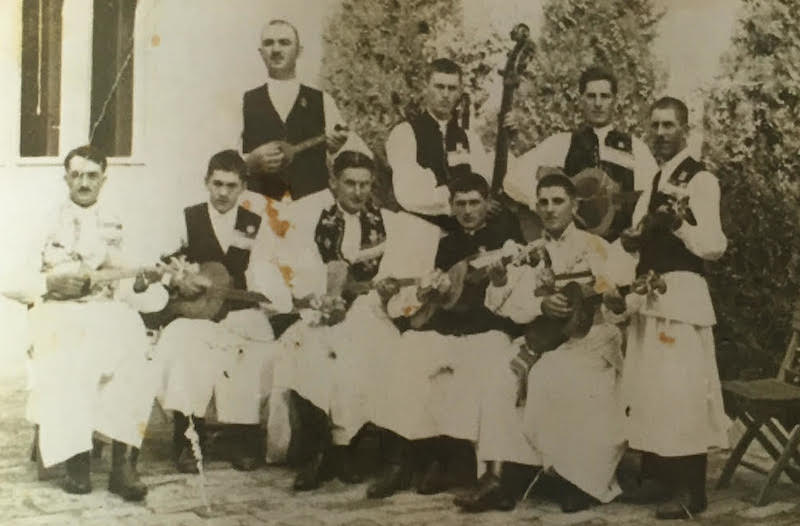

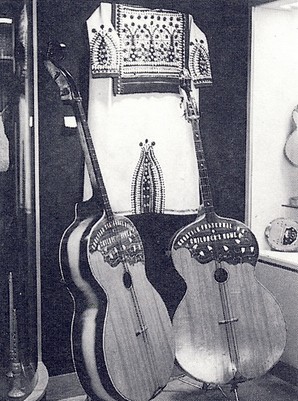
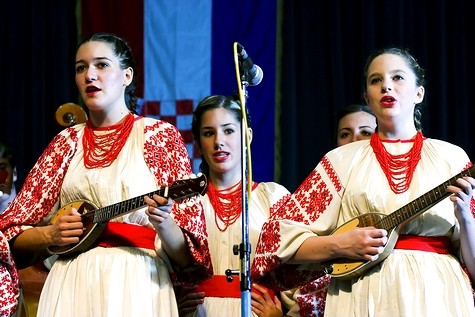
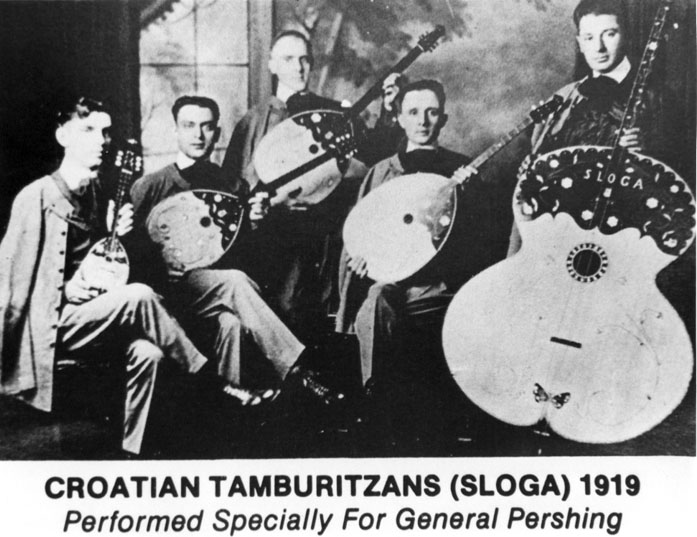
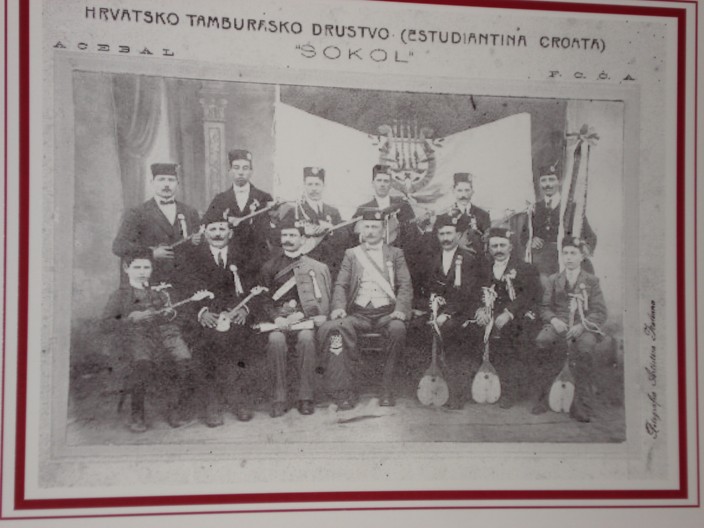
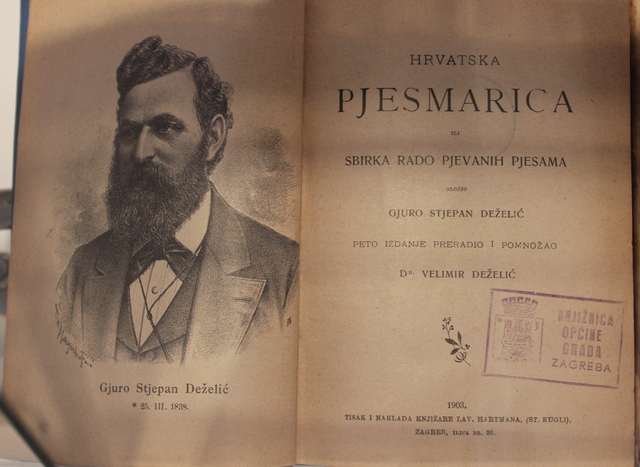
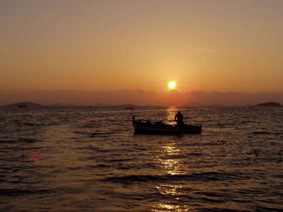
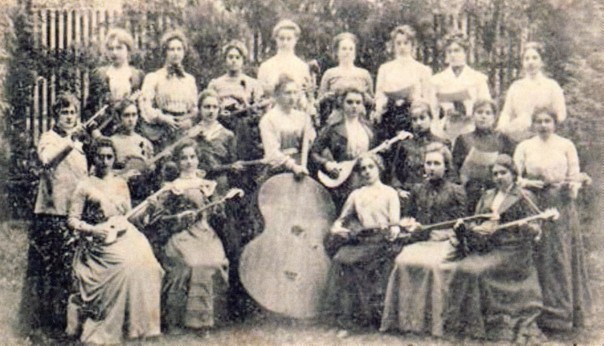
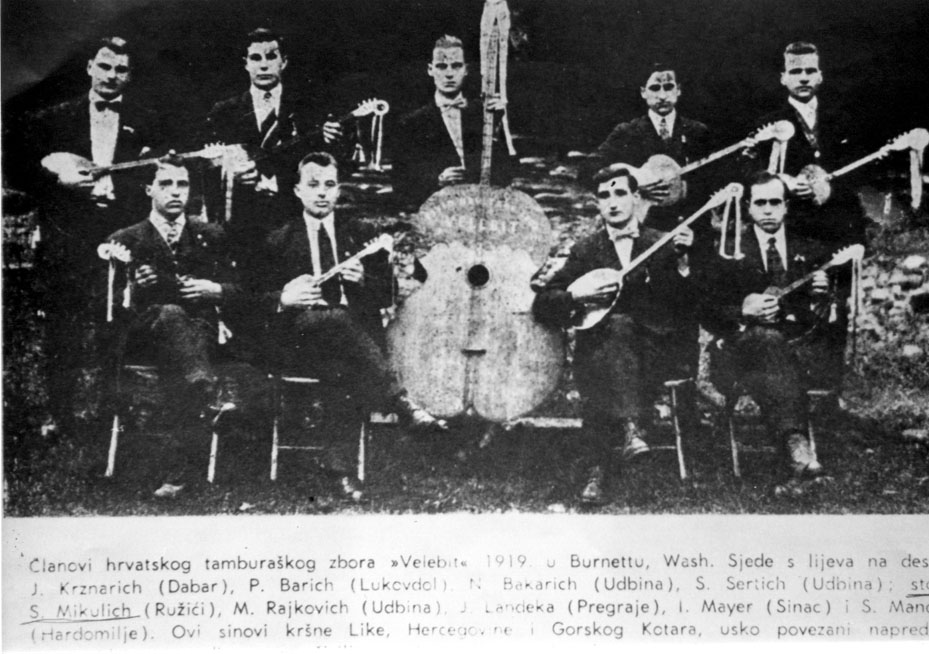
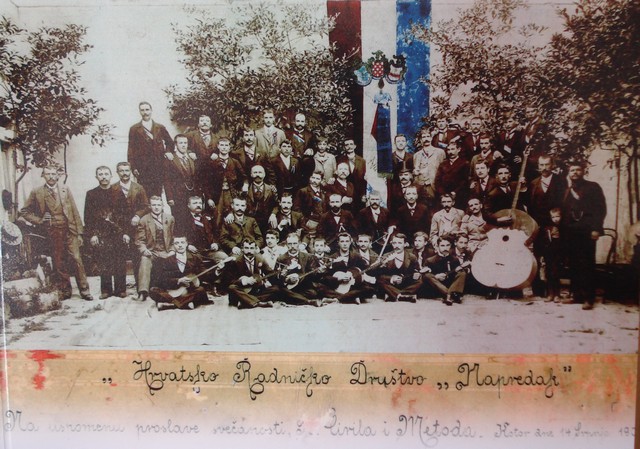
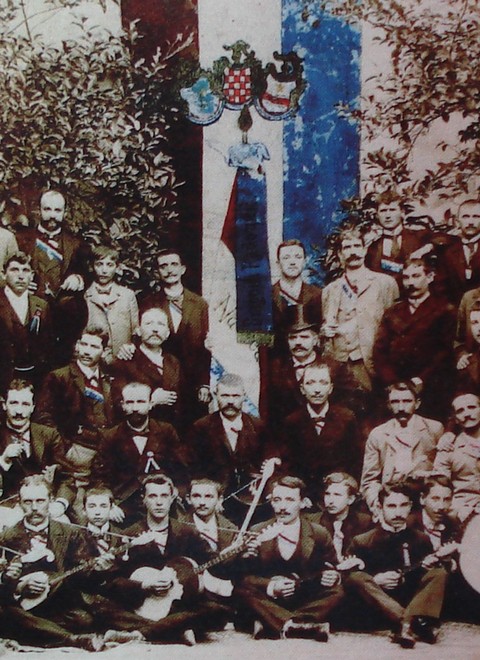

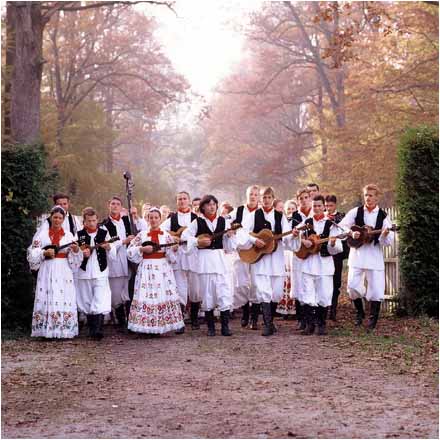 Dobro jutro moj svečaru (Rođendanska)
Dobro jutro moj svečaru (Rođendanska)